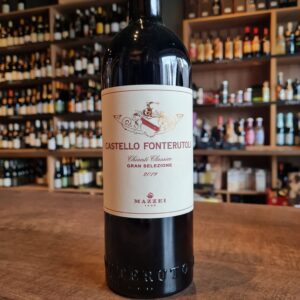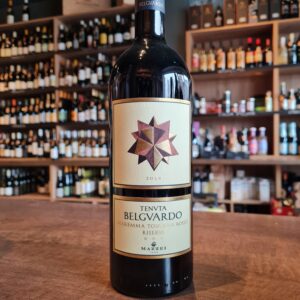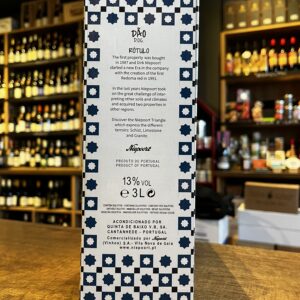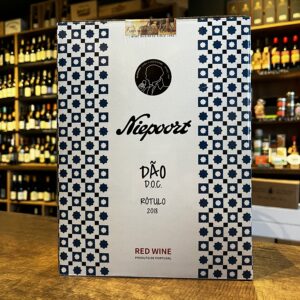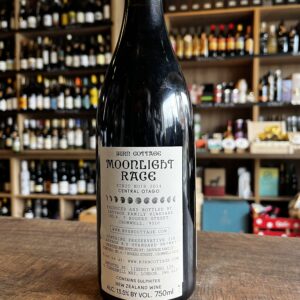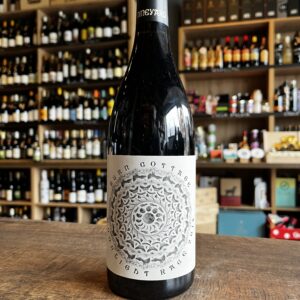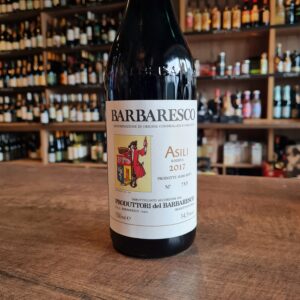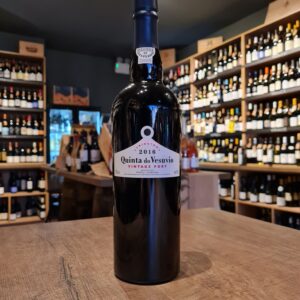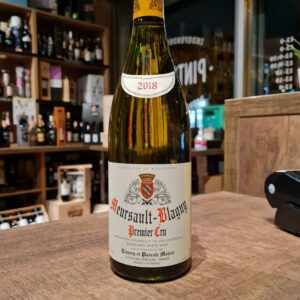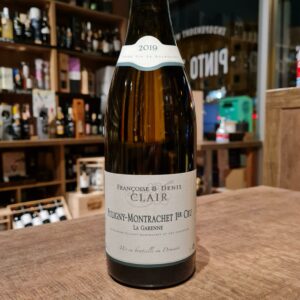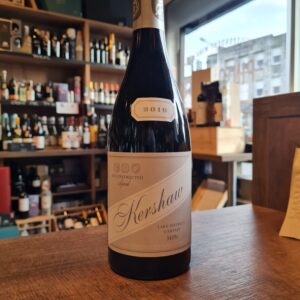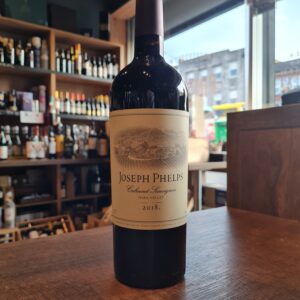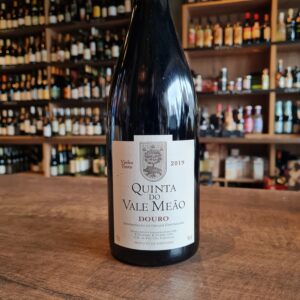-
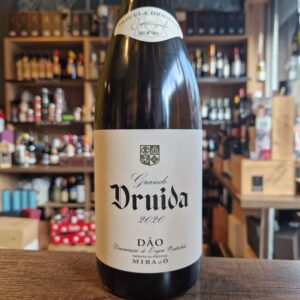 Nuno Mira do Ó is a one-man viticulture and enology powerhouse. A deep-thinking, well-traveled, generous person totally focused on expressing the great terroir of his native country. His peers look his way for guidance because his experience bringing forth wines of place covers almost every major wine region in Portugal. He launched his eponymous brand in the Dão wine region with Druida Encruzado. The wine is named for the ancient Celtic druids whose connection to the earth and plants drove their quest to achieve spiritual equilibrium through the balance of nature. As an enologist and viticulturist, Nuno is in constant search for balance between the soil, the climate, and the vines. Mira do Ó wines seek to attain perfect sensory balance with the utmost respect for nature. This is a pursuit driven by passion and a desire to share wines filled with freshness, elegance, and aging potential. These wines are handcrafted in the Dão from indigenous varietals with vineyards in granite soil sitting above 500 meters of elevation to capture the region’s cool climate. Store the bottles lying down in a cool place (15-17ºC). Drink at 11-12º C and pair with fine food.
Nuno Mira do Ó is a one-man viticulture and enology powerhouse. A deep-thinking, well-traveled, generous person totally focused on expressing the great terroir of his native country. His peers look his way for guidance because his experience bringing forth wines of place covers almost every major wine region in Portugal. He launched his eponymous brand in the Dão wine region with Druida Encruzado. The wine is named for the ancient Celtic druids whose connection to the earth and plants drove their quest to achieve spiritual equilibrium through the balance of nature. As an enologist and viticulturist, Nuno is in constant search for balance between the soil, the climate, and the vines. Mira do Ó wines seek to attain perfect sensory balance with the utmost respect for nature. This is a pursuit driven by passion and a desire to share wines filled with freshness, elegance, and aging potential. These wines are handcrafted in the Dão from indigenous varietals with vineyards in granite soil sitting above 500 meters of elevation to capture the region’s cool climate. Store the bottles lying down in a cool place (15-17ºC). Drink at 11-12º C and pair with fine food. -
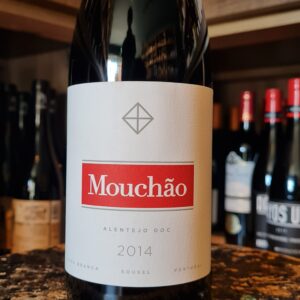 Herdade do Mouchao is a historic winery in Portugal’s Alentejo region that specialises in producing excellent red wines from the local Alicante Bouschet grape. The estate’s roots date back to the 19th century when Thomas Reynolds first moved from Porto to Alentejo to enter the prosperous cork-making industry. Later his grandson, John Reynolds saw an opportunity to start making both wine and corks and purchased the 900 hectare Herdade do Mouchao estate. Vineyards were planted, in 1901 he built a high-ceilinged adobe winery (or “adega”) and a distillery was added to the winery in 1929, where until today Mouchão's pommace brandy is produced. Unfortunately the estate was seized in 1974 by order of the powerful military government ruling the country at the time. The Reynolds were only able to regain the estate in 1985 and today the family works around 38 hectares of vines. Today, the Herdade do Mouchão continues to be run by the descendants of the original family whose cellar and vineyard workers have been with them for generations. The process is, as it always has been, unhurried (There is alway Manana). The grape varieties are local, picked by hand and foot-trodden. In the ever-changing world of winemaking, Herdade do Mouchão, remains a traditional, family-run winery.
Herdade do Mouchao is a historic winery in Portugal’s Alentejo region that specialises in producing excellent red wines from the local Alicante Bouschet grape. The estate’s roots date back to the 19th century when Thomas Reynolds first moved from Porto to Alentejo to enter the prosperous cork-making industry. Later his grandson, John Reynolds saw an opportunity to start making both wine and corks and purchased the 900 hectare Herdade do Mouchao estate. Vineyards were planted, in 1901 he built a high-ceilinged adobe winery (or “adega”) and a distillery was added to the winery in 1929, where until today Mouchão's pommace brandy is produced. Unfortunately the estate was seized in 1974 by order of the powerful military government ruling the country at the time. The Reynolds were only able to regain the estate in 1985 and today the family works around 38 hectares of vines. Today, the Herdade do Mouchão continues to be run by the descendants of the original family whose cellar and vineyard workers have been with them for generations. The process is, as it always has been, unhurried (There is alway Manana). The grape varieties are local, picked by hand and foot-trodden. In the ever-changing world of winemaking, Herdade do Mouchão, remains a traditional, family-run winery. -
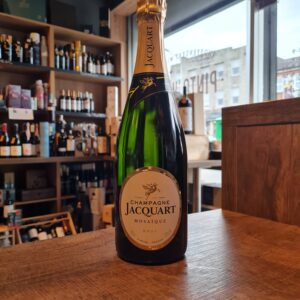 The vineyards cultivated by Jacquart winemakers cover 2,400 ha spread over sixty crus, that is to say, sixty villages throughout the Champagne area – what a mosaic! It’s within this large range of sites in Champagne that their winemaker draws together the different shades through careful assemblage, creating a cuvée that is ethereal and which seduces lovers of JACQUART. Brut Mosaïque is a wine for all times, sharing the pleasures of daily life, celebrating good news, and friends that pop round unexpectedly – this is the champagne you always have in the fridge. «Our Brut Mosaïque elegantly shows the uniqueness of our style, expressing the result of selection and choices without compromise.» Floriane Eznack THE FACTS A blend where Chardonnay is the dominant grape variety (35%-40%), giving Brut Mosaïque its freshness and delicate aromas. Pinot Noir (30%-35%) adds structure and Pinot Meunier (25% -30%) brings fruit.The grapes are sourced from exceptional terroirs, including the Grands Crus of the Côte des Blancs and the Montagne de Reims. The presence of 25% reserve wine ensures regularity of style, while more than three years ageing and a light dosage of 10 g/l result in a balanced and complex champagne. There is a time and place for this bubbly and that is anytime and everywhere! Day or night, as an aperitif or with fish or cheese. For a special occasion or for sharing with friends, Brut Mosaïque makes the moment.
The vineyards cultivated by Jacquart winemakers cover 2,400 ha spread over sixty crus, that is to say, sixty villages throughout the Champagne area – what a mosaic! It’s within this large range of sites in Champagne that their winemaker draws together the different shades through careful assemblage, creating a cuvée that is ethereal and which seduces lovers of JACQUART. Brut Mosaïque is a wine for all times, sharing the pleasures of daily life, celebrating good news, and friends that pop round unexpectedly – this is the champagne you always have in the fridge. «Our Brut Mosaïque elegantly shows the uniqueness of our style, expressing the result of selection and choices without compromise.» Floriane Eznack THE FACTS A blend where Chardonnay is the dominant grape variety (35%-40%), giving Brut Mosaïque its freshness and delicate aromas. Pinot Noir (30%-35%) adds structure and Pinot Meunier (25% -30%) brings fruit.The grapes are sourced from exceptional terroirs, including the Grands Crus of the Côte des Blancs and the Montagne de Reims. The presence of 25% reserve wine ensures regularity of style, while more than three years ageing and a light dosage of 10 g/l result in a balanced and complex champagne. There is a time and place for this bubbly and that is anytime and everywhere! Day or night, as an aperitif or with fish or cheese. For a special occasion or for sharing with friends, Brut Mosaïque makes the moment. -
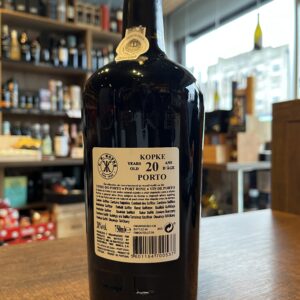
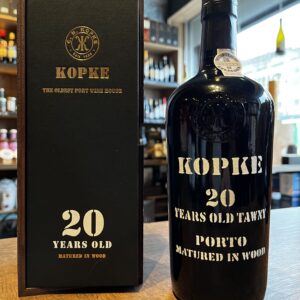 Kopke, a house specialising in aged tawny and aged white ports, is the oldest established port producer, in existence since 1638. There are special places in the world. Kopke found one of them. Quinta de São Luiz is located on the left bank of the river Douro, near Pinhão, in the parish of Tabuaço. It is an imposing estate, considered one of the most emblematic of the Douro region. The Quinta has gone through two major changes: on the one hand, the construction of the Bagaúste dam, with the consequent rise of the water level and the loss of vineyard land; on the other, the enlargement of the total area with the acquisition of several other properties in the area. The estate is made up of 125 hectares, 90 of which are planted with vines. The main grape varieties grown here are Touriga Nacional, Touriga Franca, Tinta Roriz, Tinta Cão. There are also small plots of Tinta Barroca and Souzão. The vines are classified as A, the highest grade in the Demarcated Region of the Douro. Irresistible with a starter of foie gras with aubergine and walnuts. A great choice for an endless array of desserts, such as toffee brownies, chocolate and pistachio pavé, or crostini of walnuts with chèvre. When teh weather picks up or the height of the Summer, serving this Port slightly chilly is a must.
Kopke, a house specialising in aged tawny and aged white ports, is the oldest established port producer, in existence since 1638. There are special places in the world. Kopke found one of them. Quinta de São Luiz is located on the left bank of the river Douro, near Pinhão, in the parish of Tabuaço. It is an imposing estate, considered one of the most emblematic of the Douro region. The Quinta has gone through two major changes: on the one hand, the construction of the Bagaúste dam, with the consequent rise of the water level and the loss of vineyard land; on the other, the enlargement of the total area with the acquisition of several other properties in the area. The estate is made up of 125 hectares, 90 of which are planted with vines. The main grape varieties grown here are Touriga Nacional, Touriga Franca, Tinta Roriz, Tinta Cão. There are also small plots of Tinta Barroca and Souzão. The vines are classified as A, the highest grade in the Demarcated Region of the Douro. Irresistible with a starter of foie gras with aubergine and walnuts. A great choice for an endless array of desserts, such as toffee brownies, chocolate and pistachio pavé, or crostini of walnuts with chèvre. When teh weather picks up or the height of the Summer, serving this Port slightly chilly is a must. -
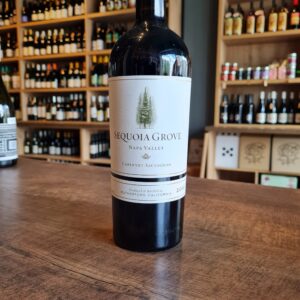 Family-owned winery Sequoia Grove was founded in 1979 in a 110-year old barn beneath a grove of Sequoia trees in Rutherford. Michael Trujillo joined the winery as assistant winemaker in 1981, becoming director of winemaking in 2002. His philosophy is based on balance in the vineyard, planting different blocks with different clones, and farming without pesticides. The family have been working with their partner growers for decades which gives them access to the very best quality fruit each year and allows them to create this complex wine which truly expresses the Rutherford terroir. The young wine is aged in oak barrel for 20 months which adds sweet spice notes and extra complexity to the finished bottling. The rich, powerful flavor profile makes this a winner with lovers of big, bold reds and a great match for red meats. Drink now through to 2030. Decanting is always recommended but is not a must
Family-owned winery Sequoia Grove was founded in 1979 in a 110-year old barn beneath a grove of Sequoia trees in Rutherford. Michael Trujillo joined the winery as assistant winemaker in 1981, becoming director of winemaking in 2002. His philosophy is based on balance in the vineyard, planting different blocks with different clones, and farming without pesticides. The family have been working with their partner growers for decades which gives them access to the very best quality fruit each year and allows them to create this complex wine which truly expresses the Rutherford terroir. The young wine is aged in oak barrel for 20 months which adds sweet spice notes and extra complexity to the finished bottling. The rich, powerful flavor profile makes this a winner with lovers of big, bold reds and a great match for red meats. Drink now through to 2030. Decanting is always recommended but is not a must -
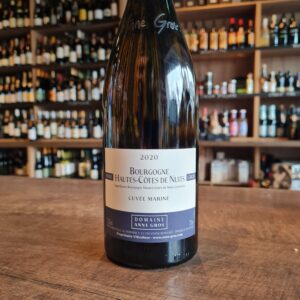 Anne Gros, the only daughter of François Gros, has established a solid character and reputation in the wine world after taking over her father’s domaine in 1988. At 25 years old, Anne saw the family domaine grow from 7 to 16 acres. Recently, she invested in a new cellar. She is a winegrower suspicious of certitude and fastidious about maintaining her freedom. As a woman winegrower, Anne knew how to prove herself and convince all who doubted of her ability to manage a domaine. She showed that she had not only the shoulders but the head to make her family heritage one of the greatest domaines of Burgundy. In 1984 she had to stop studying Arts to study vines’culture and oenology in Beaune and Dijon. Now her passion for vine and wine as well as her talent, sensitivity and professionalism posit her as a winemaker enthusiasts can rely on. Anne Gros has always been concerned about the environment, however she did not always find what she was looking for. so with this conviction, Anne Gros continued her approach to ecology without the recognition of organic certification The first harvest of this wine was 1999, Now the vines are mature and bringing very expressive fruit. This 4 acre single block parcel is situated in the commune of Concoeur just above the village of Vosne-Romanée. Originally bare of any vines, it was planted in stages (1996, 1997 and 1998). Chardonnay vines make up 2.4 acres on the upper part of the slope, where the earth is deeper and more humid (this is where the water of the hillside resurges). On the land itself: is an area rarely exceeding 300 metres in altitude in the west. the geographical diversity of burgundy leads to a diversity of climates and the existence of numerous micro-climates. the average annual insolation is 2000 hours, the average temperature is 11.5 degrees celsius. the côte de nuits is carved out of jurassic limestone. as its name suggests, the côte has a fairly steep slope. the clay-limestone complexes, the different sun exposures and the climatic data resulting from the shaping of the combes perpendicular to the fault line of the coast give us a very fragmented pdo classification system. Highly recommended with raw or grilled fish, shellfish in a court-bouillon, white meat, charcuterie without garlic and goat cheese. Fantastic Burgundy and not easy to find due to its limit production. Try it while you can
Anne Gros, the only daughter of François Gros, has established a solid character and reputation in the wine world after taking over her father’s domaine in 1988. At 25 years old, Anne saw the family domaine grow from 7 to 16 acres. Recently, she invested in a new cellar. She is a winegrower suspicious of certitude and fastidious about maintaining her freedom. As a woman winegrower, Anne knew how to prove herself and convince all who doubted of her ability to manage a domaine. She showed that she had not only the shoulders but the head to make her family heritage one of the greatest domaines of Burgundy. In 1984 she had to stop studying Arts to study vines’culture and oenology in Beaune and Dijon. Now her passion for vine and wine as well as her talent, sensitivity and professionalism posit her as a winemaker enthusiasts can rely on. Anne Gros has always been concerned about the environment, however she did not always find what she was looking for. so with this conviction, Anne Gros continued her approach to ecology without the recognition of organic certification The first harvest of this wine was 1999, Now the vines are mature and bringing very expressive fruit. This 4 acre single block parcel is situated in the commune of Concoeur just above the village of Vosne-Romanée. Originally bare of any vines, it was planted in stages (1996, 1997 and 1998). Chardonnay vines make up 2.4 acres on the upper part of the slope, where the earth is deeper and more humid (this is where the water of the hillside resurges). On the land itself: is an area rarely exceeding 300 metres in altitude in the west. the geographical diversity of burgundy leads to a diversity of climates and the existence of numerous micro-climates. the average annual insolation is 2000 hours, the average temperature is 11.5 degrees celsius. the côte de nuits is carved out of jurassic limestone. as its name suggests, the côte has a fairly steep slope. the clay-limestone complexes, the different sun exposures and the climatic data resulting from the shaping of the combes perpendicular to the fault line of the coast give us a very fragmented pdo classification system. Highly recommended with raw or grilled fish, shellfish in a court-bouillon, white meat, charcuterie without garlic and goat cheese. Fantastic Burgundy and not easy to find due to its limit production. Try it while you can -
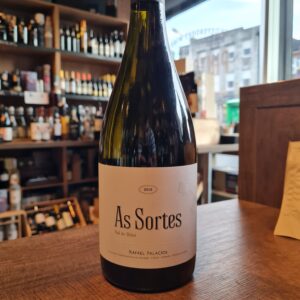 Rafael Palacios is the son of D. José Palacios Remondo (founder of Bodegas Palacios Remondo) and the brother of Alvaro Palacios(Priorat) but ultimately a passionate producer of white wine. After producing his first white at the family-run winery, called Plácet, he decided to set up his own winery in Galicia, in the Valle del Bibei, under the Valdeorras denomination. Established in 2004, Rafael Palacios has rapidly become one of Spain’s greatest producers of white wine. His focus is on the local variety Godello, grown in a small estate on very old vines that are up to 90 years old from the areas steep-sided, terraced vineyards and have been cultivated with respect of the land, without using any type of herbicide or pesticide. Rafael Palacios is refining his work year after year, reaching the magic of the greatest wines. A top wine, and one to keep. Grub pairing suggestions are mild Asian dishes, Moroccan specialities, fish ragout with saffron sauce Risotto ai frutti di mar
Rafael Palacios is the son of D. José Palacios Remondo (founder of Bodegas Palacios Remondo) and the brother of Alvaro Palacios(Priorat) but ultimately a passionate producer of white wine. After producing his first white at the family-run winery, called Plácet, he decided to set up his own winery in Galicia, in the Valle del Bibei, under the Valdeorras denomination. Established in 2004, Rafael Palacios has rapidly become one of Spain’s greatest producers of white wine. His focus is on the local variety Godello, grown in a small estate on very old vines that are up to 90 years old from the areas steep-sided, terraced vineyards and have been cultivated with respect of the land, without using any type of herbicide or pesticide. Rafael Palacios is refining his work year after year, reaching the magic of the greatest wines. A top wine, and one to keep. Grub pairing suggestions are mild Asian dishes, Moroccan specialities, fish ragout with saffron sauce Risotto ai frutti di mar -
Out of stock
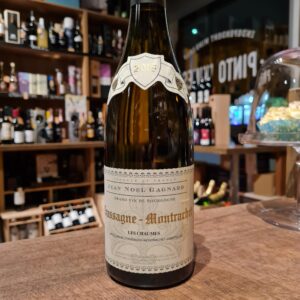 This famous Domaine has been run by Caroline Lestimé, Jean-Noël’s daughter, since 1989. Its 12.5 hectares of outstanding vineyards have been certified organic since 2014, and are now run biodynamically, though are not yet certified as such. Most of the estate’s vineyards are in the heart of Chassagne, with one vineyard in the Hautes Côtes de Beaune, which looks down on St. Aubin and was planted in 2015 at an altitude of 300 metres above sea level. The vines are Guyot-trained and planted on a moderate hill facing east. The soils here are stony calcareous clays which are enriched with biodynamic composts at the end of every winter. The wines are, in the best sense of the phrase, ‘low intervention’ wines, with each expressing the character of its site. The 2018 vintage started with good levels of winter rainfall, replenishing the soil moisture content. After a cold February and a rainy March, conditions in April were warm and dry, allowing the vineyard growth to catch up after the earlier delays. Flowering occurred under perfect conditions and summer brought consistently warm, sunny days through to harvest, which took place on August 26th. Grapes for this wine come from two similar plots: one parcel is in the upper part of the appellation (just under the road to Santenay) and the other on the lower part. 40 year old Vines Approximately 200 cases of this cuvée are made each year. Great wine to be appreciated. being an elegant and with layers of structure making this wine quite exquisite. Decanter highly recommended here.
This famous Domaine has been run by Caroline Lestimé, Jean-Noël’s daughter, since 1989. Its 12.5 hectares of outstanding vineyards have been certified organic since 2014, and are now run biodynamically, though are not yet certified as such. Most of the estate’s vineyards are in the heart of Chassagne, with one vineyard in the Hautes Côtes de Beaune, which looks down on St. Aubin and was planted in 2015 at an altitude of 300 metres above sea level. The vines are Guyot-trained and planted on a moderate hill facing east. The soils here are stony calcareous clays which are enriched with biodynamic composts at the end of every winter. The wines are, in the best sense of the phrase, ‘low intervention’ wines, with each expressing the character of its site. The 2018 vintage started with good levels of winter rainfall, replenishing the soil moisture content. After a cold February and a rainy March, conditions in April were warm and dry, allowing the vineyard growth to catch up after the earlier delays. Flowering occurred under perfect conditions and summer brought consistently warm, sunny days through to harvest, which took place on August 26th. Grapes for this wine come from two similar plots: one parcel is in the upper part of the appellation (just under the road to Santenay) and the other on the lower part. 40 year old Vines Approximately 200 cases of this cuvée are made each year. Great wine to be appreciated. being an elegant and with layers of structure making this wine quite exquisite. Decanter highly recommended here. -
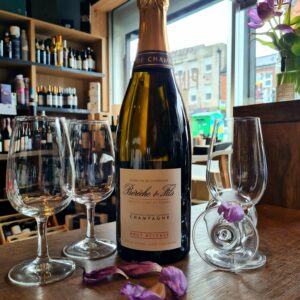 In one of mine first wine classes, the teacher said regarding pairing wines with meals. ''You can attempt everything, and please please do so, but don't matter what you will try, you will see that there is only one type of wine that will pair beautifully with all the meals throughout the day. that wine is Champagne!''. Oh dear was he right...Pair this one with a lovely cooked breakfast and you in for a treat. As for the background of this wine: Raphaël and Vincent Bérêche, two of Champagne’s rising stars, have been working alongside their father Jean-Pierre at their nine-hectare estate of Bérêche et Fils since 2004, and today they are putting an increasingly personal stamp on this thoughtfully-run Domaine. The Bérêche estate owns vines in several different sectors of Champagne, with the three primary areas being the immediate vicinity around Ludes and Craon de Ludes, the gravelly terroir of Ormes in the Petite Montagne, and the area around Mareuil-le-Port, on the left bank of the Vallée de la Marne. A small parcel is also found in Trépail, in the eastern Montagne de Reims. Most recently, the estate has acquired its first grand cru vineyard in 2012, a tiny, 15-are parcel in the village of Mailly. The estate's vineyards are planted with roughly equal parts of the three varieties, and increasing attention is being paid to natural viticulture—Bérêche completely stopped using chemical herbicides in 2004 and has planted cover crops in all of the vineyards, and since 2007 a portion of the vineyard is being converted to biodynamics. Sharp-eyed observers will note that beginning in 2013, Bérêche has changed its status from RM (récoltant-manipulant) to NM (négociant-manipulant). This was done for two reasons: the first was to augment the production of the Brut Réserve by about 15 to 20 percent, selecting grapes from three trusted growers in the villages of Ludes, Maily and Rilly-la-Montagne. These grapes will be used exclusively for the Brut Réserve, and the rest of Bérêche's wines remain entirely estate-grown. The second reason was the creation of a négociant range called Crus Sélectionnés, released under the label Raphaël et Vincent Bérêche. These are wines selected from various sources across the Champagne region, designed to illustrate and reflect their respective terroirs, with the first series of wines to be released in 2014. At Bérêche, vinification tends towards the traditional: parcels are vinified separately, with natural yeasts used for smaller tanks and selected yeasts for larger ones. The family has slowly been increasing the percentage of oak used in the cellar, and today about three-quarters of the production is vinified in barrel. The malolactic is systematically avoided, and the wines are bottled around May, without filtration and with a natural cold-settling, achieved by opening all of the cellar’s windows and waiting for three days. Disgorging is still done entirely by hand, and unlike many growers who are embracing the idea of concentrated must for the dosage, Bérèche adamantly prefers a traditional liqueur. Recently the Bérêches have begun to work more with cork for the second fermentation, believing that it results in a wine of more character and complexity. Raphaël’s father was always a firm believer in cork, but it requires a lot of extra work—now that Raphaël and Vincent are working with him at the estate, it’s easier to accomplish. Today, a quarter of the production is bottled with cork instead of capsule, spread over five different cuvées: Les Beaux Regards, Vallée de la Marne Rive Gauche, Le Cran, Reflet d'Antan and the Campania Remensis rosé. Pair it with: Oysters, Grilled fish, Salads, Cheeses, Starters & Canapes
In one of mine first wine classes, the teacher said regarding pairing wines with meals. ''You can attempt everything, and please please do so, but don't matter what you will try, you will see that there is only one type of wine that will pair beautifully with all the meals throughout the day. that wine is Champagne!''. Oh dear was he right...Pair this one with a lovely cooked breakfast and you in for a treat. As for the background of this wine: Raphaël and Vincent Bérêche, two of Champagne’s rising stars, have been working alongside their father Jean-Pierre at their nine-hectare estate of Bérêche et Fils since 2004, and today they are putting an increasingly personal stamp on this thoughtfully-run Domaine. The Bérêche estate owns vines in several different sectors of Champagne, with the three primary areas being the immediate vicinity around Ludes and Craon de Ludes, the gravelly terroir of Ormes in the Petite Montagne, and the area around Mareuil-le-Port, on the left bank of the Vallée de la Marne. A small parcel is also found in Trépail, in the eastern Montagne de Reims. Most recently, the estate has acquired its first grand cru vineyard in 2012, a tiny, 15-are parcel in the village of Mailly. The estate's vineyards are planted with roughly equal parts of the three varieties, and increasing attention is being paid to natural viticulture—Bérêche completely stopped using chemical herbicides in 2004 and has planted cover crops in all of the vineyards, and since 2007 a portion of the vineyard is being converted to biodynamics. Sharp-eyed observers will note that beginning in 2013, Bérêche has changed its status from RM (récoltant-manipulant) to NM (négociant-manipulant). This was done for two reasons: the first was to augment the production of the Brut Réserve by about 15 to 20 percent, selecting grapes from three trusted growers in the villages of Ludes, Maily and Rilly-la-Montagne. These grapes will be used exclusively for the Brut Réserve, and the rest of Bérêche's wines remain entirely estate-grown. The second reason was the creation of a négociant range called Crus Sélectionnés, released under the label Raphaël et Vincent Bérêche. These are wines selected from various sources across the Champagne region, designed to illustrate and reflect their respective terroirs, with the first series of wines to be released in 2014. At Bérêche, vinification tends towards the traditional: parcels are vinified separately, with natural yeasts used for smaller tanks and selected yeasts for larger ones. The family has slowly been increasing the percentage of oak used in the cellar, and today about three-quarters of the production is vinified in barrel. The malolactic is systematically avoided, and the wines are bottled around May, without filtration and with a natural cold-settling, achieved by opening all of the cellar’s windows and waiting for three days. Disgorging is still done entirely by hand, and unlike many growers who are embracing the idea of concentrated must for the dosage, Bérèche adamantly prefers a traditional liqueur. Recently the Bérêches have begun to work more with cork for the second fermentation, believing that it results in a wine of more character and complexity. Raphaël’s father was always a firm believer in cork, but it requires a lot of extra work—now that Raphaël and Vincent are working with him at the estate, it’s easier to accomplish. Today, a quarter of the production is bottled with cork instead of capsule, spread over five different cuvées: Les Beaux Regards, Vallée de la Marne Rive Gauche, Le Cran, Reflet d'Antan and the Campania Remensis rosé. Pair it with: Oysters, Grilled fish, Salads, Cheeses, Starters & Canapes -
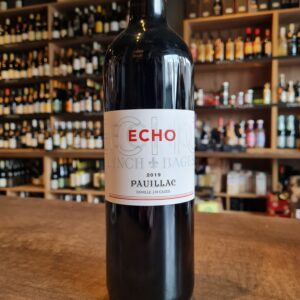 Thomas Lynch was a descendant of the Tribes of Galway. His father John emigrated in 1691 from Galway, Ireland to Bordeaux, inherited an estate in the village of Bages through his wife, Elizabeth, in 1749. This year represents the foundation of Château Lynch-Bages, which Thomas passed on to his son, Jean-Baptiste, upon his marriage in 1779. Jean-Baptiste soon handed over supervision to his brother Michel who maintained responsibility for the Bages estate until 1824, when the family sold it to a Swiss wine merchant, Sebastien Jurine, who had recently moved to Bordeaux. Château Lynch-Bages remained in the hands of the Jurine family, followed by the Cayrou family, for over a hundred years. In 1934, Jean-Charles Cazes rented the property from its then owner, Felix de Vial, subsequently purchasing it in 1938. After Jean-Charles Cazes’ death, aged 95, in 1972, the estate has been largely managed by his grandson, Jean-Michel Cazes.[2] In the late 1980s, the AXA Millésimes group began to develop a portfolio of wine property holdings, and approached Jean-Michel Cazes for help (Claude Bébéar, the AXA President, was a long-time Cazes family friend). They established Châteaux & Associés, which Cazes ran until he reached 65, and which by the end of the twentieth century owned many vineyards across Europe. Ownership of Château Lynch-Bages, however, remains with the Cazes family. In 2017, the Cazes family has acquired Château Haut-Batailley, the 1855 Grand Cru Classé estate in Pauillac. In the interest of sustainable development, agriculture is in every way reasoned: fertilization methods defined precisely and adapted to soil, optimized phytosanitary control, use of sexual confusion against worms of the bunch, controlled grassing of plots for control the vigor of the vine, prolonged rest of the soil by flowering fallow land … The use of neutral products for the environment is everywhere privileged.
Thomas Lynch was a descendant of the Tribes of Galway. His father John emigrated in 1691 from Galway, Ireland to Bordeaux, inherited an estate in the village of Bages through his wife, Elizabeth, in 1749. This year represents the foundation of Château Lynch-Bages, which Thomas passed on to his son, Jean-Baptiste, upon his marriage in 1779. Jean-Baptiste soon handed over supervision to his brother Michel who maintained responsibility for the Bages estate until 1824, when the family sold it to a Swiss wine merchant, Sebastien Jurine, who had recently moved to Bordeaux. Château Lynch-Bages remained in the hands of the Jurine family, followed by the Cayrou family, for over a hundred years. In 1934, Jean-Charles Cazes rented the property from its then owner, Felix de Vial, subsequently purchasing it in 1938. After Jean-Charles Cazes’ death, aged 95, in 1972, the estate has been largely managed by his grandson, Jean-Michel Cazes.[2] In the late 1980s, the AXA Millésimes group began to develop a portfolio of wine property holdings, and approached Jean-Michel Cazes for help (Claude Bébéar, the AXA President, was a long-time Cazes family friend). They established Châteaux & Associés, which Cazes ran until he reached 65, and which by the end of the twentieth century owned many vineyards across Europe. Ownership of Château Lynch-Bages, however, remains with the Cazes family. In 2017, the Cazes family has acquired Château Haut-Batailley, the 1855 Grand Cru Classé estate in Pauillac. In the interest of sustainable development, agriculture is in every way reasoned: fertilization methods defined precisely and adapted to soil, optimized phytosanitary control, use of sexual confusion against worms of the bunch, controlled grassing of plots for control the vigor of the vine, prolonged rest of the soil by flowering fallow land … The use of neutral products for the environment is everywhere privileged. -
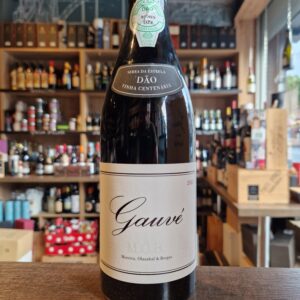 This project was born from the will of three winemakers, Jorge Moreira, Francisco Olazabal and Jorge Serôdio Borges, to make a wine together. The chosen region was the Dão, a region for which there is a common admiration that was born in the tasting of older wines, from the 60s and 70s that surprise for their elegance and freshness. The identity and complexity of these wines is indeed remarkable and serves as an inspiration for MOB wines.
This project was born from the will of three winemakers, Jorge Moreira, Francisco Olazabal and Jorge Serôdio Borges, to make a wine together. The chosen region was the Dão, a region for which there is a common admiration that was born in the tasting of older wines, from the 60s and 70s that surprise for their elegance and freshness. The identity and complexity of these wines is indeed remarkable and serves as an inspiration for MOB wines. -
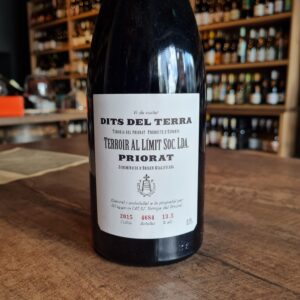 The wine Priorat Dits del Terra is a red wine produced in the Catalunya region, more precisely Priorat or the Torroja del Priorat in Spain, by Terroir al Limit. The vineyards are south facing in the sun-baked slate hills of Priorat and 60+ year old carignan vines are not usually harbingers of floral elegance and silken grace. And yet this gap between expectation and stunning creation is precisely what makes Dits de Terra so iconic. The vineyard, one of the original Terroir Al Limit holdings, honors the Cyprus trees that shade the historic Eremitas throughout the region. It is crafted using whole bunch fermentation and initial vinification in cement, then afforded a rare gift: time, in the form of 16 months in Stockinger foudres and cement, with a gentle and unobtrusive elevage. This care and attention elevates it into a fine, complex and fluid expression of different terroirs. The dark depths in the glass belie its ephemeral lightness in aroma and flavor. Breathy black fruits and a persistent herbality enhance the supple spice and suspended movement across the palate. Anise, fresh fennel and rose notes are underscored with a fluid web of balsamic accents - never weighty nor wide. The wine exudes gravitas with the elegant confidence that comes only from complete comfort in one’s own skin. Only 2000 bottles produced, Masterclass of a wine!
The wine Priorat Dits del Terra is a red wine produced in the Catalunya region, more precisely Priorat or the Torroja del Priorat in Spain, by Terroir al Limit. The vineyards are south facing in the sun-baked slate hills of Priorat and 60+ year old carignan vines are not usually harbingers of floral elegance and silken grace. And yet this gap between expectation and stunning creation is precisely what makes Dits de Terra so iconic. The vineyard, one of the original Terroir Al Limit holdings, honors the Cyprus trees that shade the historic Eremitas throughout the region. It is crafted using whole bunch fermentation and initial vinification in cement, then afforded a rare gift: time, in the form of 16 months in Stockinger foudres and cement, with a gentle and unobtrusive elevage. This care and attention elevates it into a fine, complex and fluid expression of different terroirs. The dark depths in the glass belie its ephemeral lightness in aroma and flavor. Breathy black fruits and a persistent herbality enhance the supple spice and suspended movement across the palate. Anise, fresh fennel and rose notes are underscored with a fluid web of balsamic accents - never weighty nor wide. The wine exudes gravitas with the elegant confidence that comes only from complete comfort in one’s own skin. Only 2000 bottles produced, Masterclass of a wine! -
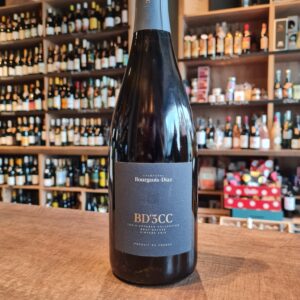 Located in Crouttes-sur-Marne, about 25km east of Meaux, the Bourgeois Diaz vineyard comprises 6.80 hectares of vines, of which 3.5 hectares are planted with Pinot Meunier, 2 with Pinot Noir and 1.3 with Chardonnay. The vines are on average 40 years old and have their roots in soils of clay, silt and chalk . Jérôme is the fourth generation of winegrowers on his father's side. His wife Charlotte, joined the estate in 2016, and today plays an important role in overseeing the estate, helping to develop the quality of the Champagnes. No pesticides, no chemical fertilizers, no technological manipulation, the wines of Jérôme and Charlotte are not only cared for, they are loved. The estate has been certified in organic and biodynamic viticulture since 2014. The biodynamic preparations 5 00P (twice a year) and 501 (3 to 4 times a year) are combined with low doses of copper and sulfur, horsetail decoctions, nettle, wicker, meadowsweet, chamomile, yarrow herbal teas, etc. Green manures are sown every other row, and an agro-forestry project was launched in 2019 (planting of 50 trees in a plot of 45 ares). Most of the work is done manually, foot by foot, to bring the maximum attention to the vines, which explains why the estate employs almost one person per hectare year-round. The harvest is manual, and most of the pickers are regulars, knowing the terroir and the state of mind of the estate. The bunches are harvested when ripe and sorted, so as to bring in grapes only in perfect sanitary condition. Disgorged on 01/12/2019 after 5 years of ageing, this non-dosed brut nature Champagne is straight, ample and deep, with great complexity brought by the long aging in the bottle Pair it with Lobster, bar carpaccio, lean tartare, Saint-Pierre, sweetbreads. Salut!!
Located in Crouttes-sur-Marne, about 25km east of Meaux, the Bourgeois Diaz vineyard comprises 6.80 hectares of vines, of which 3.5 hectares are planted with Pinot Meunier, 2 with Pinot Noir and 1.3 with Chardonnay. The vines are on average 40 years old and have their roots in soils of clay, silt and chalk . Jérôme is the fourth generation of winegrowers on his father's side. His wife Charlotte, joined the estate in 2016, and today plays an important role in overseeing the estate, helping to develop the quality of the Champagnes. No pesticides, no chemical fertilizers, no technological manipulation, the wines of Jérôme and Charlotte are not only cared for, they are loved. The estate has been certified in organic and biodynamic viticulture since 2014. The biodynamic preparations 5 00P (twice a year) and 501 (3 to 4 times a year) are combined with low doses of copper and sulfur, horsetail decoctions, nettle, wicker, meadowsweet, chamomile, yarrow herbal teas, etc. Green manures are sown every other row, and an agro-forestry project was launched in 2019 (planting of 50 trees in a plot of 45 ares). Most of the work is done manually, foot by foot, to bring the maximum attention to the vines, which explains why the estate employs almost one person per hectare year-round. The harvest is manual, and most of the pickers are regulars, knowing the terroir and the state of mind of the estate. The bunches are harvested when ripe and sorted, so as to bring in grapes only in perfect sanitary condition. Disgorged on 01/12/2019 after 5 years of ageing, this non-dosed brut nature Champagne is straight, ample and deep, with great complexity brought by the long aging in the bottle Pair it with Lobster, bar carpaccio, lean tartare, Saint-Pierre, sweetbreads. Salut!! -
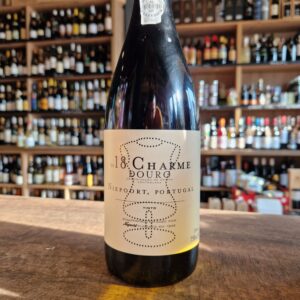 Another excellent wine from Niepoort. Charme is all about elegance and balance, achieved by taking special attention to the smallest details during the entire wine-making process. Made in traditional stone lagares with 100% grape stems, Charme’s elegance is achieved using grapes from very old vineyards in Vale de Mendiz, on the banks of the Pinhão river. Pair it with mushrooms and game dishes, such as partridge or pheasant
Another excellent wine from Niepoort. Charme is all about elegance and balance, achieved by taking special attention to the smallest details during the entire wine-making process. Made in traditional stone lagares with 100% grape stems, Charme’s elegance is achieved using grapes from very old vineyards in Vale de Mendiz, on the banks of the Pinhão river. Pair it with mushrooms and game dishes, such as partridge or pheasant -
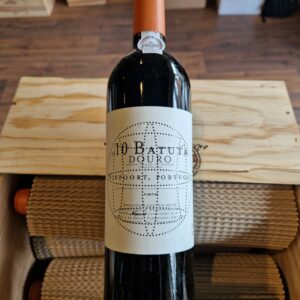 Niepoort is a family business dating back to 1842. Its winemaking tradition began in the Douro region, with the roduction of Port wine. Nowadays has a foothold in all the major Portuguese regions with still wines production outside the Douro Valley. Know-how, enthusiasm and an innovative mindset have passed down from generation to generation, making Niepoort one of the most authentic and notable Portuguese wine producers. The grapes to produce this wine come from Quinta do Carril, from a north-facing vineyard with more than 70 years, and also from old vineyards about 100 years old near Quinta de Nápoles. Niepoort sums up this elegant bottling well by saying “Batuta is a wine of extremes, having more of everything, is at the same time, the one with a more discrete behavior.” Quite so this year (and most), as the wine opens with subtlety and elegance, seeming rather mute. It is somewhat tinged by oak early in its life. That will be easily absorbed. It takes some air and patience to see what this sometimes too subtle wine has, but there is good structure underneath (and a little tannic pop that emerges with air) that should allow the wine to develop well and have the time to acquire some complexity, which is often its best feature. It has a very Burgundian feel, with a silky, graceful mid-palate. There is nothing obvious about this bottling in any year. This year, certainly, it is a Batuta that is perhaps subtle to a fault, but it will be a perfect food wine and when you are drinking it you will suddenly realize how much you like it.'' Time will tell, definitely one of the great current masters of winemaking. Not just in Portugal but in the world
Niepoort is a family business dating back to 1842. Its winemaking tradition began in the Douro region, with the roduction of Port wine. Nowadays has a foothold in all the major Portuguese regions with still wines production outside the Douro Valley. Know-how, enthusiasm and an innovative mindset have passed down from generation to generation, making Niepoort one of the most authentic and notable Portuguese wine producers. The grapes to produce this wine come from Quinta do Carril, from a north-facing vineyard with more than 70 years, and also from old vineyards about 100 years old near Quinta de Nápoles. Niepoort sums up this elegant bottling well by saying “Batuta is a wine of extremes, having more of everything, is at the same time, the one with a more discrete behavior.” Quite so this year (and most), as the wine opens with subtlety and elegance, seeming rather mute. It is somewhat tinged by oak early in its life. That will be easily absorbed. It takes some air and patience to see what this sometimes too subtle wine has, but there is good structure underneath (and a little tannic pop that emerges with air) that should allow the wine to develop well and have the time to acquire some complexity, which is often its best feature. It has a very Burgundian feel, with a silky, graceful mid-palate. There is nothing obvious about this bottling in any year. This year, certainly, it is a Batuta that is perhaps subtle to a fault, but it will be a perfect food wine and when you are drinking it you will suddenly realize how much you like it.'' Time will tell, definitely one of the great current masters of winemaking. Not just in Portugal but in the world -
 These fresh and lovely whites were carefully chosen to make you travel through different parts of the world in comfort with a glass in hand. These are fresh, light, crispy, open wines that are super delicious and will test your taste buds and impress. Ferdinand Mayr Grüner Veltliner- Ferdinand Mayr is a musician turned winemaker and his organic wines are singing with flavour and intensity. Whoever says Grüner Veltliner says Austria and vice versa. This version of Ferdinand Mayr is accessible and it charms you right away. Exuberant, lively nose of citrus, apple and white pepper. On the palate, the ripe fruit and spiciness create a pleasant tension with the acidity. Crispy and ripe, as if you were biting into a juicy apple. Flavor and spiciness characterize this wine. Fantastic with Japanese or Thai cuisine. Portuga White Lisboa- A wine that presents itself as modern, with excellent aromatic intensity and offering citric fruit notes. With a light body, it has also a great natural freshness and shows great balance in the aftertaste. Antonio Rubini Pinot Grigio delle Venezie- Italian Pinot Grigio through and through with no surprises. This wine shows apple and pear with hints of white peach and elderflower. Light and refreshing, a mouth-watering partner for salads and seafood. Great any day of the week. Les Chaises Sauvignon Blanc- Another one that won't disappoint. This is a Languedoc Roussillon white made for the locals in South West France. Delicious, fresh zesty lemon and green apple flavours, lively and refreshing with good length. Ideal as an aperitif, with seafood, white meats, goats cheese and salads. Marlborough Sun Sauvignon Blanc- This absolutely stunning New Zealand white is what you expect from a sauvignon blanc from Marlborough and more. The inspiration for the labels came from a newspaper article about an unusual phenomenon that has swept the region... Pioneri Mundi Albariño- If you are a fan of Spanish Albariños, this one just ticks the box. Fantastic, all rounder and easy to drink, perfect for any occasion. Compliments all sorts of food, especially Tapas.
These fresh and lovely whites were carefully chosen to make you travel through different parts of the world in comfort with a glass in hand. These are fresh, light, crispy, open wines that are super delicious and will test your taste buds and impress. Ferdinand Mayr Grüner Veltliner- Ferdinand Mayr is a musician turned winemaker and his organic wines are singing with flavour and intensity. Whoever says Grüner Veltliner says Austria and vice versa. This version of Ferdinand Mayr is accessible and it charms you right away. Exuberant, lively nose of citrus, apple and white pepper. On the palate, the ripe fruit and spiciness create a pleasant tension with the acidity. Crispy and ripe, as if you were biting into a juicy apple. Flavor and spiciness characterize this wine. Fantastic with Japanese or Thai cuisine. Portuga White Lisboa- A wine that presents itself as modern, with excellent aromatic intensity and offering citric fruit notes. With a light body, it has also a great natural freshness and shows great balance in the aftertaste. Antonio Rubini Pinot Grigio delle Venezie- Italian Pinot Grigio through and through with no surprises. This wine shows apple and pear with hints of white peach and elderflower. Light and refreshing, a mouth-watering partner for salads and seafood. Great any day of the week. Les Chaises Sauvignon Blanc- Another one that won't disappoint. This is a Languedoc Roussillon white made for the locals in South West France. Delicious, fresh zesty lemon and green apple flavours, lively and refreshing with good length. Ideal as an aperitif, with seafood, white meats, goats cheese and salads. Marlborough Sun Sauvignon Blanc- This absolutely stunning New Zealand white is what you expect from a sauvignon blanc from Marlborough and more. The inspiration for the labels came from a newspaper article about an unusual phenomenon that has swept the region... Pioneri Mundi Albariño- If you are a fan of Spanish Albariños, this one just ticks the box. Fantastic, all rounder and easy to drink, perfect for any occasion. Compliments all sorts of food, especially Tapas. -
 For those red wine lovers. You know what I mean by red lips! We brought together for you a red wine case of 6 bottles full of character, lavish richness, booming dark fruits, warming spice flavours, and velvet-smooth down to the very last drop. With this case you will travel from Portugal, Spain through France and Italy all the way to California. No doubt you will develop some red wine lips... Lab Tinto Lisboa - Lab tested and Lab approved! Full bodied, red produced on the coast of Lisbon, is smooth and is very aromatic with notes of ripe black and red fruits. On the palate, juicy plums and dark berry fruit flavour with plenty of fresh yet fine tannins that take over at the finish, along with flavours of spice and liquorice. It is not a top shelf wine but it does punch above its weight. Michel Chapoutier Marius - As Marius, Michel Chapoutier’s great-grandfather, always said ‘A good wine is one that beckons us to take another sip’. This wine carries this message and reflects the warmth of the southern french terroirs in which they are rooted. Dark red, dense, clear wine with deep purple shimmer. On the nose: powerful, complex, dark, spicy, red berries, delicate floral note. Château Haut Gravelier - Château Gravelier is located on superb hillsides on the edge of Entre Deux Mers, Bordeaux. Classic French blend of 70% Merlot 30% Cabernet Sauvignon. With deep colour, classic structure and unusually ripe flavours, this is classic claret to serve with roast beef, duck or T-bone steak. Palacio del Camino Crianza Rioja - The simple enjoyment of a really good Rioja is sometimes forgotten. But here one is, great with food, but honestly, just as great in a large glass on a sofa with nowhere to be and nothing to do. An elegant fruity wine with vanilla, spices and red fruit. Monte del Frá Bardolino DOC - This charming and typical red wine from Veneto is a cuvée made from 65% Corvina, 30% Rondinella and 5% Sangiovese, the usual suspects as Italian red grape varieties go. On the nose exudes aromas of different types of cherries, raspberries and strawberries. A whole range of spicy overtones and undertones play around this fruity core: cloves, cinnamon, violets and pepper. Tannins and fruit acid are perfectly coordinated. In the finale, some more cinnamon and black pepper. I would pair this one with pasta or your favourite comfort food. Beringer Zinfandel California - A Zin that definitely portrays some Classic California ripeness. Ripe blueberries, blackberries, plums, a hint of smoky and mineral characters and a touch perfumed (dried floral notes) on the nose. On the palate you'll find that smoke and berry ripeness coming through, with a little tangy raspberry adding to a lengthy finish. Medium plus body with a silky mouthfeel, smooth light tannins and luscious acidity. I love Zins with a juicy bacon and smoked cheddar burger or with your favourite pizza. This one should not disappoint!
For those red wine lovers. You know what I mean by red lips! We brought together for you a red wine case of 6 bottles full of character, lavish richness, booming dark fruits, warming spice flavours, and velvet-smooth down to the very last drop. With this case you will travel from Portugal, Spain through France and Italy all the way to California. No doubt you will develop some red wine lips... Lab Tinto Lisboa - Lab tested and Lab approved! Full bodied, red produced on the coast of Lisbon, is smooth and is very aromatic with notes of ripe black and red fruits. On the palate, juicy plums and dark berry fruit flavour with plenty of fresh yet fine tannins that take over at the finish, along with flavours of spice and liquorice. It is not a top shelf wine but it does punch above its weight. Michel Chapoutier Marius - As Marius, Michel Chapoutier’s great-grandfather, always said ‘A good wine is one that beckons us to take another sip’. This wine carries this message and reflects the warmth of the southern french terroirs in which they are rooted. Dark red, dense, clear wine with deep purple shimmer. On the nose: powerful, complex, dark, spicy, red berries, delicate floral note. Château Haut Gravelier - Château Gravelier is located on superb hillsides on the edge of Entre Deux Mers, Bordeaux. Classic French blend of 70% Merlot 30% Cabernet Sauvignon. With deep colour, classic structure and unusually ripe flavours, this is classic claret to serve with roast beef, duck or T-bone steak. Palacio del Camino Crianza Rioja - The simple enjoyment of a really good Rioja is sometimes forgotten. But here one is, great with food, but honestly, just as great in a large glass on a sofa with nowhere to be and nothing to do. An elegant fruity wine with vanilla, spices and red fruit. Monte del Frá Bardolino DOC - This charming and typical red wine from Veneto is a cuvée made from 65% Corvina, 30% Rondinella and 5% Sangiovese, the usual suspects as Italian red grape varieties go. On the nose exudes aromas of different types of cherries, raspberries and strawberries. A whole range of spicy overtones and undertones play around this fruity core: cloves, cinnamon, violets and pepper. Tannins and fruit acid are perfectly coordinated. In the finale, some more cinnamon and black pepper. I would pair this one with pasta or your favourite comfort food. Beringer Zinfandel California - A Zin that definitely portrays some Classic California ripeness. Ripe blueberries, blackberries, plums, a hint of smoky and mineral characters and a touch perfumed (dried floral notes) on the nose. On the palate you'll find that smoke and berry ripeness coming through, with a little tangy raspberry adding to a lengthy finish. Medium plus body with a silky mouthfeel, smooth light tannins and luscious acidity. I love Zins with a juicy bacon and smoked cheddar burger or with your favourite pizza. This one should not disappoint! -
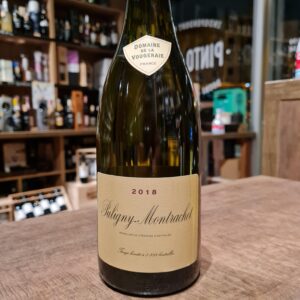 Domaine de La Vougeraie is born from the assembly of domains acquired over time and the vines of the family. Its history dates back to 1964 with the first vine, Les Evocelles, acquired by our father at his very beginnings. Here, it is in his village that he will have his first lands around Gevrey-Chambertin. The reputation of Domaine de la Vougeraie is well established. This area of excellence is located in Premeaux-Prissey, a small village in Burgundy , near Nuits-Saint-Georges, in the Côte de Nuits . For this cuvée, the estate brings together two small plots in the “ La Rue aux Vaches ” and “ Noyer Bret ” climates . They are planted with Chardonnay and worked in biodynamics , homeopathy applied to the vine. 2018 was a generous, sunny vintage, which managed to maintain a good level of freshness Sylvie Poillot, General Manager, farms the estate’s 42 hectares biodynamically. “We do this to preserve the fertility of soils, and to have a very good balance between the soil and the plant’s health,” she explains. It’s not just the soil health that’s changed: two decades on from their conversion to biodynamics, the wines are evolving too: “The wines are more aromatic and more expressive year after year,” she says. A fascinating 2018: on the one hand, it’s opulent with the warmth of the vintage; on the other, it’s tight with typical Puligny fruit, stone and bite. A superior example. Drink 2022-2028 Great with grilled fish, scallops, lobster, lobster
Domaine de La Vougeraie is born from the assembly of domains acquired over time and the vines of the family. Its history dates back to 1964 with the first vine, Les Evocelles, acquired by our father at his very beginnings. Here, it is in his village that he will have his first lands around Gevrey-Chambertin. The reputation of Domaine de la Vougeraie is well established. This area of excellence is located in Premeaux-Prissey, a small village in Burgundy , near Nuits-Saint-Georges, in the Côte de Nuits . For this cuvée, the estate brings together two small plots in the “ La Rue aux Vaches ” and “ Noyer Bret ” climates . They are planted with Chardonnay and worked in biodynamics , homeopathy applied to the vine. 2018 was a generous, sunny vintage, which managed to maintain a good level of freshness Sylvie Poillot, General Manager, farms the estate’s 42 hectares biodynamically. “We do this to preserve the fertility of soils, and to have a very good balance between the soil and the plant’s health,” she explains. It’s not just the soil health that’s changed: two decades on from their conversion to biodynamics, the wines are evolving too: “The wines are more aromatic and more expressive year after year,” she says. A fascinating 2018: on the one hand, it’s opulent with the warmth of the vintage; on the other, it’s tight with typical Puligny fruit, stone and bite. A superior example. Drink 2022-2028 Great with grilled fish, scallops, lobster, lobster -
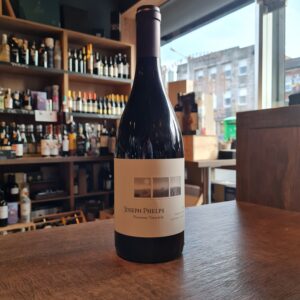 It began with a vision. A belief in the possibility of something bigger and better – something that didn’t quite exist yet. In the early 1970s, Napa Valley was a sleepy agricultural town on the brink of a fine-wine awakening. Drawing on his construction experience, Joe set about establishing the building blocks of winemaking excellence. By embedding his no-compromise philosophy deep into the bedrock of the winery, Joe set the framework to push for greatness. In 1974, he had the idea to make a unique blend each year, one that would represent the finest wine he could make from each vintage. He didn’t necessarily think it would always be a Cabernet Sauvignon either. His only thought was to make one wine that represented the best of Joseph Phelps Vineyards. Today, Insignia is widely regarded as a qualitative benchmark for Californian winemaking that has earned Joseph Phelps its longstanding reputation for excellence. The production has been scaled back to the point where all the fruit comes from estate vineyards, which is something of a rarity in California. This is now a brilliantly focused, dynamic producer that refuses to rest on its laurels. In our honest opinion in Pinto Wines this wine can compare easely with top Burgundy wines at this price point. We have aged some of these wines in store and are ready to be enjoyed.
It began with a vision. A belief in the possibility of something bigger and better – something that didn’t quite exist yet. In the early 1970s, Napa Valley was a sleepy agricultural town on the brink of a fine-wine awakening. Drawing on his construction experience, Joe set about establishing the building blocks of winemaking excellence. By embedding his no-compromise philosophy deep into the bedrock of the winery, Joe set the framework to push for greatness. In 1974, he had the idea to make a unique blend each year, one that would represent the finest wine he could make from each vintage. He didn’t necessarily think it would always be a Cabernet Sauvignon either. His only thought was to make one wine that represented the best of Joseph Phelps Vineyards. Today, Insignia is widely regarded as a qualitative benchmark for Californian winemaking that has earned Joseph Phelps its longstanding reputation for excellence. The production has been scaled back to the point where all the fruit comes from estate vineyards, which is something of a rarity in California. This is now a brilliantly focused, dynamic producer that refuses to rest on its laurels. In our honest opinion in Pinto Wines this wine can compare easely with top Burgundy wines at this price point. We have aged some of these wines in store and are ready to be enjoyed. -
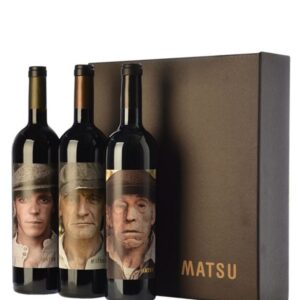 Matsu, the Japanese word for 'wait', pays homage to the generations of devoted wine makers. The images of the real-life wine-producers decorate the bottle and represent the essence of each of the wines. Picaro means 'rogue' or 'rascal', and this rapscallion of a wine is a youthful interpretation of the Toro region's style. El Recio translates as 'the tough guy', and is a more serious, mature wine, made from the product of some of Toro's oldest vines. 'The Old One' of the Matsu range, made from the fruit of selected Tinta de Toro vines, averaging 110 years of age - presented in an original gift box.
Matsu, the Japanese word for 'wait', pays homage to the generations of devoted wine makers. The images of the real-life wine-producers decorate the bottle and represent the essence of each of the wines. Picaro means 'rogue' or 'rascal', and this rapscallion of a wine is a youthful interpretation of the Toro region's style. El Recio translates as 'the tough guy', and is a more serious, mature wine, made from the product of some of Toro's oldest vines. 'The Old One' of the Matsu range, made from the fruit of selected Tinta de Toro vines, averaging 110 years of age - presented in an original gift box. -
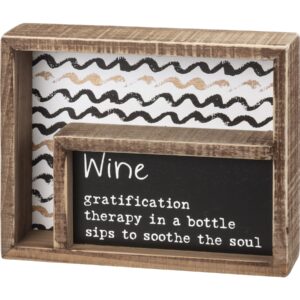 Wine is cheaper than Therapy! We put together these great wines, 3 whites and 3 reds that would put a smile on anyone's face, any day of the week. These wines can be enjoyed with or without food, but we always recommend a nibble. On the whites: Muralhas Vinho Verde - Monção e Melgaço has been producing wines and recognized for it since Roman occupation times, but was with Afonso III, 5th King of Portugal(1210-1279) that signed a ”Foral” that conceded Monção e Melgaço habitants the owners of the local wine and therefore they produced it with pride as they do today. The wine is made from the Alvarinho (predominant) and Trajadura varieties, indigenous to Portugal and the region, more specifically. The dry Muralhas de Moncao Vinho Verde never seems intrusive, but is soft, elegant and harmonious with no wood whatsoever. The wine goes well not only as an aperitif, but also with salads, seafood, fish dishes and white meat. Vitese Colomba Bianca Grillo Biologico- Grillo is the flagship of Sicily's indigenous white varieties, with its aromatic and floral nose. Fresh and harmonious on the well-structured palate, the Vitese Grillo has a long and elegant finish. Lovingly white, Lovingly good !! Bardos Rueda Verdejo- This artisan verdejo is part of the reason the Spanish Rueda region has become quite popular. Made unapologetically, you will find yourself like a true "Bard" drinking this wine. Delicious! On The Reds El Castro de Valtuille Joven - Made by the great Raul Perez. Fresh, mineral-tinged redcurrant and cherry scents that show very good clarity. Tangy, focused and pure on the palate, offering intense flavors of bitter cherry and red berry preserves. Shows a light touch that's quite pinot-like, along with a touch of smokiness that carries through a long, mineral-driven finish. If you want to show somebody what the Spanish region of Mencia smells, feels and tastes like, serve this one. Adega de Penalva Dão 'Indigena' Tinto -Adega de Penalva wines are delicious everyday examples of one of Portugal’s most intriguing appellations — the Dão. Perched above the Dão river itself as it snakes through its granite valleys, the Adega de Penalva is one of the leading cooperatives in the area, boasting around a thousand member growers. It’s important to note, though, that the average holding per member amounts to barely over a hectare—a figure that reminds us how tenaciously much of rural Portugal clings to its old ways. (On that note, all fruit destined for the ‘Indigena’ bottlings is hand-harvested.) Since its founding in the 1960s, the Adega has been collecting its members’ grapes and producing clean, characterful wines with a minimum of fuss. Aromas of leather and blueberries and notes of dark fruits with cherry and raspberry. Tank N32 Primitivo Appassimento IGT - Couldn't finish this wine case without bringing out the guns. This passionate and very well intended Italian red impresses with its perfect combination of elegance and strength. The bouquet reveals aromas of ripe cherries, juicy plums and dried fruit. In particular figs, dates and raisins come to mind. Has a dense and concentrated character. The pleasant and equally subtle residual sweetness gives this red wine a wonderful velvetiness. The long finish of Tank No 32 is carried by delicate notes of nougat and dark chocolate.
Wine is cheaper than Therapy! We put together these great wines, 3 whites and 3 reds that would put a smile on anyone's face, any day of the week. These wines can be enjoyed with or without food, but we always recommend a nibble. On the whites: Muralhas Vinho Verde - Monção e Melgaço has been producing wines and recognized for it since Roman occupation times, but was with Afonso III, 5th King of Portugal(1210-1279) that signed a ”Foral” that conceded Monção e Melgaço habitants the owners of the local wine and therefore they produced it with pride as they do today. The wine is made from the Alvarinho (predominant) and Trajadura varieties, indigenous to Portugal and the region, more specifically. The dry Muralhas de Moncao Vinho Verde never seems intrusive, but is soft, elegant and harmonious with no wood whatsoever. The wine goes well not only as an aperitif, but also with salads, seafood, fish dishes and white meat. Vitese Colomba Bianca Grillo Biologico- Grillo is the flagship of Sicily's indigenous white varieties, with its aromatic and floral nose. Fresh and harmonious on the well-structured palate, the Vitese Grillo has a long and elegant finish. Lovingly white, Lovingly good !! Bardos Rueda Verdejo- This artisan verdejo is part of the reason the Spanish Rueda region has become quite popular. Made unapologetically, you will find yourself like a true "Bard" drinking this wine. Delicious! On The Reds El Castro de Valtuille Joven - Made by the great Raul Perez. Fresh, mineral-tinged redcurrant and cherry scents that show very good clarity. Tangy, focused and pure on the palate, offering intense flavors of bitter cherry and red berry preserves. Shows a light touch that's quite pinot-like, along with a touch of smokiness that carries through a long, mineral-driven finish. If you want to show somebody what the Spanish region of Mencia smells, feels and tastes like, serve this one. Adega de Penalva Dão 'Indigena' Tinto -Adega de Penalva wines are delicious everyday examples of one of Portugal’s most intriguing appellations — the Dão. Perched above the Dão river itself as it snakes through its granite valleys, the Adega de Penalva is one of the leading cooperatives in the area, boasting around a thousand member growers. It’s important to note, though, that the average holding per member amounts to barely over a hectare—a figure that reminds us how tenaciously much of rural Portugal clings to its old ways. (On that note, all fruit destined for the ‘Indigena’ bottlings is hand-harvested.) Since its founding in the 1960s, the Adega has been collecting its members’ grapes and producing clean, characterful wines with a minimum of fuss. Aromas of leather and blueberries and notes of dark fruits with cherry and raspberry. Tank N32 Primitivo Appassimento IGT - Couldn't finish this wine case without bringing out the guns. This passionate and very well intended Italian red impresses with its perfect combination of elegance and strength. The bouquet reveals aromas of ripe cherries, juicy plums and dried fruit. In particular figs, dates and raisins come to mind. Has a dense and concentrated character. The pleasant and equally subtle residual sweetness gives this red wine a wonderful velvetiness. The long finish of Tank No 32 is carried by delicate notes of nougat and dark chocolate. -
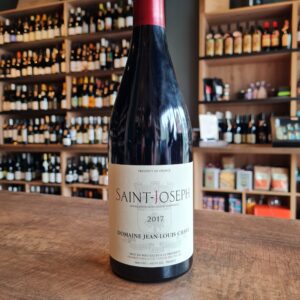 Since 1481, the Chave family has been lording the soils of the Hermitage. Probably they are amongst the best visionaries and observers of the French wines in general. The vineyards are cultivated organically, with methods that favor very low yields and full ripeness, followed by minimal intervention in the winemaking process. The family's pride and joy is the Syrah planted on the fabled hill of Hermitage, but their wines from Saint-Joseph, a small nearby village devoted to the same grape, are a close second and represent distinct value. Syrah here doesn't taste like the bombastic syrah of California or Australia; rather, it's smoky, savory, and tastes like blackberries and black pepper.
Since 1481, the Chave family has been lording the soils of the Hermitage. Probably they are amongst the best visionaries and observers of the French wines in general. The vineyards are cultivated organically, with methods that favor very low yields and full ripeness, followed by minimal intervention in the winemaking process. The family's pride and joy is the Syrah planted on the fabled hill of Hermitage, but their wines from Saint-Joseph, a small nearby village devoted to the same grape, are a close second and represent distinct value. Syrah here doesn't taste like the bombastic syrah of California or Australia; rather, it's smoky, savory, and tastes like blackberries and black pepper. -
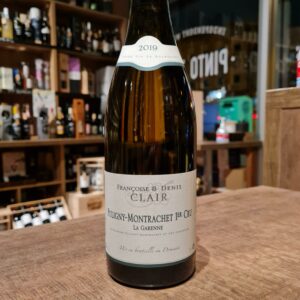 Denis Clair, quick with a laugh and a textbook bon vivant, created the domaine in 1986. The Clair family had owned parcels in the area for generations but sold most of their production to negociants. Denis set out to bottle his own wine. His wife Françoise was born in Saint-Aubin, a neighboring AOC village 2 1/2 miles to the northwest (a bit longer by car). This is where the Clairs' winery is located. They have a son, Jean-Baptiste, who joined the family business in 2000 working the vines. Jean-Baptist eventually began making their white wines. Today the family owns 15 hectares, including parcels in Santenay and Saint-Aubin. They sell 75,000 bottles a year, with about 75% of that going abroad. Fantastic with lobster, langoustines, turbot, a fillet of Saint-Pierre with fine vegetables, all shellfish and crustaceans, sole... Also unique with fine white meats, including pheasant with a beautiful cream sauce. Stunning gift and a bucket list wine
Denis Clair, quick with a laugh and a textbook bon vivant, created the domaine in 1986. The Clair family had owned parcels in the area for generations but sold most of their production to negociants. Denis set out to bottle his own wine. His wife Françoise was born in Saint-Aubin, a neighboring AOC village 2 1/2 miles to the northwest (a bit longer by car). This is where the Clairs' winery is located. They have a son, Jean-Baptiste, who joined the family business in 2000 working the vines. Jean-Baptist eventually began making their white wines. Today the family owns 15 hectares, including parcels in Santenay and Saint-Aubin. They sell 75,000 bottles a year, with about 75% of that going abroad. Fantastic with lobster, langoustines, turbot, a fillet of Saint-Pierre with fine vegetables, all shellfish and crustaceans, sole... Also unique with fine white meats, including pheasant with a beautiful cream sauce. Stunning gift and a bucket list wine -
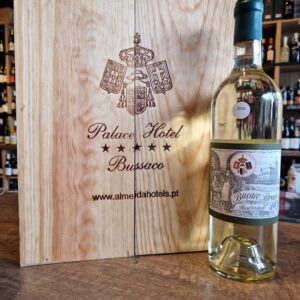 Alexandre de Almeida, founder of the oldest hotel chain in Portugal with the same name, began producing Buçaco Wines in 1917 when he realized what the Hotel Winery concept meant after many visits to European hotels, including those on the French “Côte D’Azure”. This gave him the idea to open his own winery at the Buçaco Palace, starting to produce varieties that would come to be known as the glorious “Buçaco wines”. In the early 20th century, one of the most interesting pages on Portuguese wine was created, the wine that was to become a much-envied icon, but which was always intentionally kept out of the limelight. Its creator, Alexandre de Almeida, adopted the concept of linking luxury hotels to a winery with their own wine. If we look back, ever since the first harvests we realized the importance of this icon that was served to kings, queens and heads of state, as proven by menus, proudly kept at the Hotel Palace Buçaco. Buçaco wines were just that: objects of culture limited to very restricted circles, the elite. Their fantastic and noble labels still bear the symbol of their nobility to this day and age. The Buçaco wines were and still are always produced in the same way using the same methods as in the past. The fact that the grapes come from the Dão and Bairrada regions guarantees a wonderful wine that nobly develops in the bottle. If you happen to visit this unique 5* Hotel, just North of Coimbra(between Lisbon and Porto) you will be in for an experience. Situated in the Bussaco National Forest, this 5-star hotel occupies the hunting palace of the last Portuguese kings. Palace Hotel do Bussaco is an excellent example of Manueline-Gothic architecture. Its richly decorated corridors feature antique furnishings, large paintings and traditional Portuguese glazed tiles. Its elegant restaurant offers a range of exclusive Bussaco wines(only). Classic French cuisine and traditional Portuguese dishes are served at Palace Hotel do Bussaco’s restaurant. It is decorated with paintings by João Vaz, Moorish ceilings and exotic hardwood floors. Guests can try a glass of rare Port vintage at the bar. Fantastic experience with amazing wines
Alexandre de Almeida, founder of the oldest hotel chain in Portugal with the same name, began producing Buçaco Wines in 1917 when he realized what the Hotel Winery concept meant after many visits to European hotels, including those on the French “Côte D’Azure”. This gave him the idea to open his own winery at the Buçaco Palace, starting to produce varieties that would come to be known as the glorious “Buçaco wines”. In the early 20th century, one of the most interesting pages on Portuguese wine was created, the wine that was to become a much-envied icon, but which was always intentionally kept out of the limelight. Its creator, Alexandre de Almeida, adopted the concept of linking luxury hotels to a winery with their own wine. If we look back, ever since the first harvests we realized the importance of this icon that was served to kings, queens and heads of state, as proven by menus, proudly kept at the Hotel Palace Buçaco. Buçaco wines were just that: objects of culture limited to very restricted circles, the elite. Their fantastic and noble labels still bear the symbol of their nobility to this day and age. The Buçaco wines were and still are always produced in the same way using the same methods as in the past. The fact that the grapes come from the Dão and Bairrada regions guarantees a wonderful wine that nobly develops in the bottle. If you happen to visit this unique 5* Hotel, just North of Coimbra(between Lisbon and Porto) you will be in for an experience. Situated in the Bussaco National Forest, this 5-star hotel occupies the hunting palace of the last Portuguese kings. Palace Hotel do Bussaco is an excellent example of Manueline-Gothic architecture. Its richly decorated corridors feature antique furnishings, large paintings and traditional Portuguese glazed tiles. Its elegant restaurant offers a range of exclusive Bussaco wines(only). Classic French cuisine and traditional Portuguese dishes are served at Palace Hotel do Bussaco’s restaurant. It is decorated with paintings by João Vaz, Moorish ceilings and exotic hardwood floors. Guests can try a glass of rare Port vintage at the bar. Fantastic experience with amazing wines -
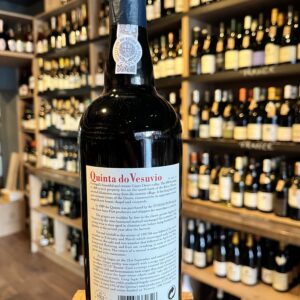
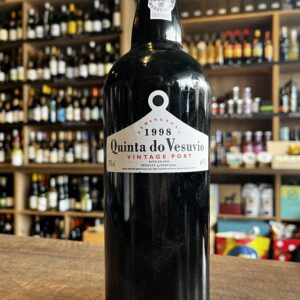 A Vintage Port is only declared in years of exceptional quality. Quinta do Vesuvio is arguably the most magnificent estate in the Douro valley. Located in the beautiful and austere Port-growing region of the Upper Douro valley, its history dates back to the 16th Century. “The quinta of all quintas – one of the wonders of the world”. At Vesuvio, the work of man and the work of nature achieve a perfect and enduring harmony. More than anywhere else in the Douro it has a haunting and enchanting beauty; when you leave it, you take with you a sense of the place that does not fade with time.
A Vintage Port is only declared in years of exceptional quality. Quinta do Vesuvio is arguably the most magnificent estate in the Douro valley. Located in the beautiful and austere Port-growing region of the Upper Douro valley, its history dates back to the 16th Century. “The quinta of all quintas – one of the wonders of the world”. At Vesuvio, the work of man and the work of nature achieve a perfect and enduring harmony. More than anywhere else in the Douro it has a haunting and enchanting beauty; when you leave it, you take with you a sense of the place that does not fade with time. -
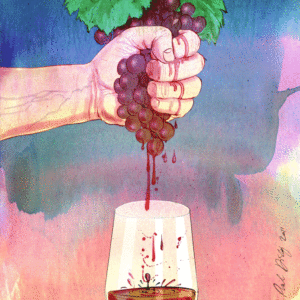 More and more wine producers are adopting organic winemaking as the way forward, and they are stunning wines out there. There are many reasons why people enjoy organic wines. For some, it became a way of life, for others it just “feels right”. The old fear ''I don't trust organic wines'' or ''They all taste the same'' is disappearing, with more people converting to organic wines as there is more knowledge, greater quality and a heavily regulated market that will certify these wines. We brought you a case for any occasion with easy drinking 6 bottles. They say natural wine can be tricky to understand, well no expertise needed with these wines. An essential mix of light, low sulphite, crisp fresh white and a soft, pleasurable red. All organic, all vegan, all tasty. No need to drown in the complexity of natural wine, just try these and enjoy. Bardos Rueda Verdejo - This artisan verdejo is part of the reason the Spanish Rueda region has become quite popular. Made unapologetically, you will find yourself like a true “Bard” drinking this wine. Delicious! Sepp Gruner Veltliner - All Sepp Moser wines have been organic (and all estate wines biodynamic) since 2007. Delicate aromas of pear, kiwi, apricot and white spice. On the palate stone fruit flavours and white pepper lead to a gently textured, mineral and citrus finish. Combel La Serre L'Epatant Antidote Rosé - 100% French Malbec (known in Cahors as Auxerrois). The vines are 40 years old, grown on clay and limestone soils. Fermentation and aging take place in small tanks."The Splendid Antidote to the Heat of the Causse" is the amusing and appropriate name of this refreshing rosé. (The Causse is the high limestone plateau around Cahors, which gets brutally hot in the summer.) The wine shows a pretty pink/orange color and aromas of ripe cherry, raspberry and cassis with citrus and spice. It precedes a palate that is both fleshy, suave and savory, with formidable gluttony. Both easy and winey, it's an absolute delight! Roche-Audran, ‘Nature’ Còtes-du-Rhône - Vincent Rochette comes from a long line of grape growers rather than winemakers up until 1998 when he bucked that trend by investing in a cellar and the necessary equipment to allow him to vinify his own grapes . He uses only natural products in the vineyard and carries out all his work in keeping with the cosmic cycles of the earth, not only among the vines but also in the cellar. One of his most interesting cuvées is the Côte du Rhone ‘Nature’, which has had no sulphites added at any stage of the winemaking process. Due to the fact that sulphites are naturally present in grapes, there are still 9mg present (below the legal 10mg limit which is required to state that the wine contains sulphites), an insignificant figure compared to the conventional levels found in most wines. The result is a wine that is simply a pure expression of Grenache, Carignan, Syrah and Mourvèdre. Harvesting, racking and bottling are all carried out in accordance with cosmic rhythms. Pitti Pittnauer Red - High on the hills of Austria there is more than just a lonely goat herd – there is also a fantastic winery, considered one of the country’s best. Pittnauer has a long winemaking tradition in the region, and in 2006 moved to more biodynamic practices. The results are delicious, environmentally friendly wines with years of experience behind them. Now prepare yourself for some varieties you’ve probably never heard of – Pittnauer’s Pitti Red Blend is made from blaufränkisch and Zweigelt grapes with a small quantity of Merlot added to the mixture. Filipa Pato Dinâmica Baga 2019 - Filipa Pato is the confirmation of the old saying "son of fish knows how to swim". Although she followed the footsteps of her father Luís Pato, Filipa went on her own and started a project in 2001. The success was immediate, and soon she rose to the status of one of the most brilliant winemakers in Portugal. Her wines are the result of Filipa's innovative and brilliant spirit. They were quickly at the forefront of national and international criticism. Dinâmica Baga is a wine that, due to its proximity to the sea, presents an intense, complex and elegant aroma with a touch of fruit such as strawberry and plum, nuances of liquorice and notes of spices such as black pepper, bay leaves and thyme, and balanced acidity. In the mouth it is fruity, with a beautiful structure and velvety texture, with a very fresh and inviting finish.
More and more wine producers are adopting organic winemaking as the way forward, and they are stunning wines out there. There are many reasons why people enjoy organic wines. For some, it became a way of life, for others it just “feels right”. The old fear ''I don't trust organic wines'' or ''They all taste the same'' is disappearing, with more people converting to organic wines as there is more knowledge, greater quality and a heavily regulated market that will certify these wines. We brought you a case for any occasion with easy drinking 6 bottles. They say natural wine can be tricky to understand, well no expertise needed with these wines. An essential mix of light, low sulphite, crisp fresh white and a soft, pleasurable red. All organic, all vegan, all tasty. No need to drown in the complexity of natural wine, just try these and enjoy. Bardos Rueda Verdejo - This artisan verdejo is part of the reason the Spanish Rueda region has become quite popular. Made unapologetically, you will find yourself like a true “Bard” drinking this wine. Delicious! Sepp Gruner Veltliner - All Sepp Moser wines have been organic (and all estate wines biodynamic) since 2007. Delicate aromas of pear, kiwi, apricot and white spice. On the palate stone fruit flavours and white pepper lead to a gently textured, mineral and citrus finish. Combel La Serre L'Epatant Antidote Rosé - 100% French Malbec (known in Cahors as Auxerrois). The vines are 40 years old, grown on clay and limestone soils. Fermentation and aging take place in small tanks."The Splendid Antidote to the Heat of the Causse" is the amusing and appropriate name of this refreshing rosé. (The Causse is the high limestone plateau around Cahors, which gets brutally hot in the summer.) The wine shows a pretty pink/orange color and aromas of ripe cherry, raspberry and cassis with citrus and spice. It precedes a palate that is both fleshy, suave and savory, with formidable gluttony. Both easy and winey, it's an absolute delight! Roche-Audran, ‘Nature’ Còtes-du-Rhône - Vincent Rochette comes from a long line of grape growers rather than winemakers up until 1998 when he bucked that trend by investing in a cellar and the necessary equipment to allow him to vinify his own grapes . He uses only natural products in the vineyard and carries out all his work in keeping with the cosmic cycles of the earth, not only among the vines but also in the cellar. One of his most interesting cuvées is the Côte du Rhone ‘Nature’, which has had no sulphites added at any stage of the winemaking process. Due to the fact that sulphites are naturally present in grapes, there are still 9mg present (below the legal 10mg limit which is required to state that the wine contains sulphites), an insignificant figure compared to the conventional levels found in most wines. The result is a wine that is simply a pure expression of Grenache, Carignan, Syrah and Mourvèdre. Harvesting, racking and bottling are all carried out in accordance with cosmic rhythms. Pitti Pittnauer Red - High on the hills of Austria there is more than just a lonely goat herd – there is also a fantastic winery, considered one of the country’s best. Pittnauer has a long winemaking tradition in the region, and in 2006 moved to more biodynamic practices. The results are delicious, environmentally friendly wines with years of experience behind them. Now prepare yourself for some varieties you’ve probably never heard of – Pittnauer’s Pitti Red Blend is made from blaufränkisch and Zweigelt grapes with a small quantity of Merlot added to the mixture. Filipa Pato Dinâmica Baga 2019 - Filipa Pato is the confirmation of the old saying "son of fish knows how to swim". Although she followed the footsteps of her father Luís Pato, Filipa went on her own and started a project in 2001. The success was immediate, and soon she rose to the status of one of the most brilliant winemakers in Portugal. Her wines are the result of Filipa's innovative and brilliant spirit. They were quickly at the forefront of national and international criticism. Dinâmica Baga is a wine that, due to its proximity to the sea, presents an intense, complex and elegant aroma with a touch of fruit such as strawberry and plum, nuances of liquorice and notes of spices such as black pepper, bay leaves and thyme, and balanced acidity. In the mouth it is fruity, with a beautiful structure and velvety texture, with a very fresh and inviting finish. -
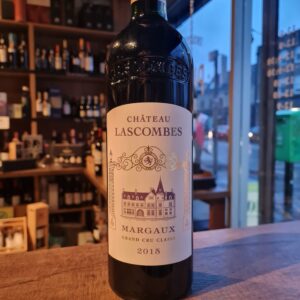 The iconic, ivy-covered Château Lascombes is one of the most recognizable structures in all of Margaux. One would never expect this picturesque and secluded estate to have one of the largest vineyards in the Médoc. The vineyard is an astounding 120 hectares primarily located in Margaux; with 10 hectares in the Haut-Médoc appellation. With a staff of 36, one can imagine the harvest period on such a vast estate would be difficult to manage. Because of their access to state-of-the-art technology and some of the most desirable plots in Margaux, the viticultural team of Château Lascombes produces wines that continue to impress and receive critical acclaim. Château Lascombes earned its namesake after its owner, Antoine Chevalier de Lascombes in 1625. The estate was inherited from the Durfort de Duras family who also owned Château Durfort – later known as the famed Second Growth property, Château Durfort-Vivens. Château Lascombes was classified as a Second Growth estate in 1855, but its history really began when it was purchased almost a hundred years later. Alexis Lichine and a group of investors – including the wealthy American, David Rockefeller – purchased the estate in 1952. There is a diverse array of soil types at Château Lascombes. Gravelly outcroppings are planted with Cabernet Sauvignon and Petit Verdot. The property also has limestone terroir, which is highly unique to the Margaux region. It is the areas with clay and limestone where the primary varietal at Château Lascombes, Merlot, really shines. Château Lascombes has 50% of its vineyard planted with Merlot – an unusual choice for an estate in Margaux. The vines are on average 35 years old, and only 50-hectares of the sprawling vineyard are considered able to produce the wines of top Second Growth quality. The estate is presently managed by Dominique Befve, who brings his expertise from ten years as technical director at Château Lafite Rothschild and Duhart Milon. Upon his arrival, Dominique oversaw major technical innovations to the cellar. The cellar astonishes visitors with its signature blue lights and technologically advanced Oxoline racks. The racks rotate the barrels and keep the lees of the wine in suspension, reducing oxidation and making the wine round and more immediately accessible. Open at least 1 hour before tasting, this Margaux finesse will be preferred at the time of entry (meat) or on your cheese board (soft and hard pasta).
The iconic, ivy-covered Château Lascombes is one of the most recognizable structures in all of Margaux. One would never expect this picturesque and secluded estate to have one of the largest vineyards in the Médoc. The vineyard is an astounding 120 hectares primarily located in Margaux; with 10 hectares in the Haut-Médoc appellation. With a staff of 36, one can imagine the harvest period on such a vast estate would be difficult to manage. Because of their access to state-of-the-art technology and some of the most desirable plots in Margaux, the viticultural team of Château Lascombes produces wines that continue to impress and receive critical acclaim. Château Lascombes earned its namesake after its owner, Antoine Chevalier de Lascombes in 1625. The estate was inherited from the Durfort de Duras family who also owned Château Durfort – later known as the famed Second Growth property, Château Durfort-Vivens. Château Lascombes was classified as a Second Growth estate in 1855, but its history really began when it was purchased almost a hundred years later. Alexis Lichine and a group of investors – including the wealthy American, David Rockefeller – purchased the estate in 1952. There is a diverse array of soil types at Château Lascombes. Gravelly outcroppings are planted with Cabernet Sauvignon and Petit Verdot. The property also has limestone terroir, which is highly unique to the Margaux region. It is the areas with clay and limestone where the primary varietal at Château Lascombes, Merlot, really shines. Château Lascombes has 50% of its vineyard planted with Merlot – an unusual choice for an estate in Margaux. The vines are on average 35 years old, and only 50-hectares of the sprawling vineyard are considered able to produce the wines of top Second Growth quality. The estate is presently managed by Dominique Befve, who brings his expertise from ten years as technical director at Château Lafite Rothschild and Duhart Milon. Upon his arrival, Dominique oversaw major technical innovations to the cellar. The cellar astonishes visitors with its signature blue lights and technologically advanced Oxoline racks. The racks rotate the barrels and keep the lees of the wine in suspension, reducing oxidation and making the wine round and more immediately accessible. Open at least 1 hour before tasting, this Margaux finesse will be preferred at the time of entry (meat) or on your cheese board (soft and hard pasta). -
 Hello my enthusiastic brethren or should I say Oenophilians! (I've just butchered the word a lit bit but I am sure you can relate to it). Wine Oenophilia is a love of wine. In the strictest sense, oenophilia describes a disciplined devotion to wine, accompanying strict traditions of consumption and appreciation. Wine lovers are also known as wine aficionados and connoisseurs. Its the people who appreciate and collect wine, particularly grape wines from certain regions, varieties or production methods. Maybe someone like you... So in the spirit of Oenophilia, I have put together 6 wines for those wine aficionados that want to push the bar a little further and feel excited. Here you have 2 whites, 1 bubbly and 3 reds, all of them are totally different from each other, underrated, unique and perform superbly in their own categories. Whites: Celler del Roure Cullerot 2019- This "orange" wine from Valencia is produced by Pablo Calatayud from Celler del Roure and let's say he brought the entire winemaking process back to basics. This is a blend of six different grapes, of which three of them were revived from ancient vines that were no longer in use. The setting is in an ancient country estate outside of Moixent, in the Valencia region. For centuries this was a farm producing grain, almonds, olives and grapes for the production of olive oil and wine. This farm contained a large, stone, olive press and extensive subterranean cellar with dozens of intact 17th century amphorae. It took a few years of research and restoration but Pablo is using these clay vessels to make wine once again. Cullerot, which means tadpole, is the white that Pablo makes in the old cellar utilizing Verdil, Pedro Ximénez, Macabeo and Chardonnay from vines ranging in age from 15–70 years old. Whole cluster pressing, natural yeast fermentation and aging in amphorae seems familiar, but it is in fact, timeless. Moment of Silence by Blankbottle - Blankbottle is not bound to a specific wine area or wine style. It’s from many different vineyards, scattered across the Western Cape of South Africa, different regions, micro-climates, soil types, and ultimately leads to different wine styles. It is driven by quality, adventure, excitement and mystery. And at the centre of it all, are the guys in the vineyards, viticulturists, winemakers, family, friends and Blankbottle fans. Stunning, all rounder there is nothing you can fault in this wine. Aromas of candied lemon, cooked apple and mango with a core of minerality. Soft and voluptuous, it has a lovely ripeness and a fleshy, creamy mouthfeel, which leads to a perfect tangy freshness giving some zip to its otherwise mellow feel. Filipa Pato 3B Sparkling Rosé- The Filipa Pato 3B Sparkling Rosé is a delicious treat of a wine from one of my favorite winemakers in Portugal. Filipa Pato is the daughter of arguably one of Portugal's most famous winemakers, Luis Pato. She is also married to a very famous Belgian Sommelier William Wouters. Despite of all of these influences, she is a fantastic winemaker in her own right since 2001. Filipa became famous when she deviated from the local traditional methods and started producing unique wines out of local indigenous grapes (Baga & Bical) that are biodynamic with minimum intervention and true to themselves and their terroir . Filipa's mantra is 'vinhos autênticos sem maquilagem' – Authentic Wines Without Makeup. The color of the 3B Rosé is a beautiful light pink. It’s soft on the nose, with light yeast, mineral, rose and strawberry aromatics. The palate is quite dry, with firm mineral flavors complemented by lemon and light raspberry. The mouthfeel is fantastically bubbly. It’s a very tasty, mineral-centric sparkler. Niepoort Voyeur 1 Ltr- Never a winemaker to shy away from experimentation, Dirk Niepoort has spent the last few years trialling amphora vinification. This is the upshot of those experiments: the first release of a field blend of old-vine red and white grapes, which spent eight months fermenting and ageing in six 1000L clay amphorae. One of the aims of the project was to reset expectations of Douro reds - all power, body and muscle. Instead, Voyeur is all about freshness, lightness and elegance, clocking in at only 12.5% alcohol. There is plenty of complexity here, partly from the sheer number of varieties in the blend; partly from earthy amphora notes. But what’s most striking is the pure red fruit and delicate florality of the wine. Chill slightly before serving and savour the freshness. Susumaniello IGP Puglia - The winery "i Pàstini", located in the heart of the Valle d'Itria land, strives to maintain the wisdom of traditions even with modern winemaking techniques, thus managing to obtain the best of enology Puglia has to offer. The vines are imported from nearby Dalmatia, which is one of the most important indigenous vines of the Brindisi area. Its name (there are several theories) is due to the fact that, a long time ago, the young Susumaniello plant was particularly productive, so much so, that it was overloaded with bunches as if it were a donkey. This unknown wine is underrated but will impress for its uniqueness and test your knowledge on how wine in general should taste like. This is a succulent and voluptuous wine with intense aromas of coffee liqueur, dark berry fruits and cocoa. Chat Fou Côtes du Rhône by Éric Texier - If you were ever sceptical about Organic wines, you have to give this one a try! This wine is Artisanal, Organic, Biodynamic, unfined and unfiltered. All with the aim to do as little intervention as possible and to let the Terroir speak for itself. Eric Texier Chat Fou natural red wine is a coupage of Grenache Tinta, Clairette and Marsanne, from the well known region of Côtes du Rhône.Eric Texier is a vigneron from Brézème, a municipality in the northern area of the Rhone Valley. For every occasion, red and white meats, charcuterie and to impress your other half.
Hello my enthusiastic brethren or should I say Oenophilians! (I've just butchered the word a lit bit but I am sure you can relate to it). Wine Oenophilia is a love of wine. In the strictest sense, oenophilia describes a disciplined devotion to wine, accompanying strict traditions of consumption and appreciation. Wine lovers are also known as wine aficionados and connoisseurs. Its the people who appreciate and collect wine, particularly grape wines from certain regions, varieties or production methods. Maybe someone like you... So in the spirit of Oenophilia, I have put together 6 wines for those wine aficionados that want to push the bar a little further and feel excited. Here you have 2 whites, 1 bubbly and 3 reds, all of them are totally different from each other, underrated, unique and perform superbly in their own categories. Whites: Celler del Roure Cullerot 2019- This "orange" wine from Valencia is produced by Pablo Calatayud from Celler del Roure and let's say he brought the entire winemaking process back to basics. This is a blend of six different grapes, of which three of them were revived from ancient vines that were no longer in use. The setting is in an ancient country estate outside of Moixent, in the Valencia region. For centuries this was a farm producing grain, almonds, olives and grapes for the production of olive oil and wine. This farm contained a large, stone, olive press and extensive subterranean cellar with dozens of intact 17th century amphorae. It took a few years of research and restoration but Pablo is using these clay vessels to make wine once again. Cullerot, which means tadpole, is the white that Pablo makes in the old cellar utilizing Verdil, Pedro Ximénez, Macabeo and Chardonnay from vines ranging in age from 15–70 years old. Whole cluster pressing, natural yeast fermentation and aging in amphorae seems familiar, but it is in fact, timeless. Moment of Silence by Blankbottle - Blankbottle is not bound to a specific wine area or wine style. It’s from many different vineyards, scattered across the Western Cape of South Africa, different regions, micro-climates, soil types, and ultimately leads to different wine styles. It is driven by quality, adventure, excitement and mystery. And at the centre of it all, are the guys in the vineyards, viticulturists, winemakers, family, friends and Blankbottle fans. Stunning, all rounder there is nothing you can fault in this wine. Aromas of candied lemon, cooked apple and mango with a core of minerality. Soft and voluptuous, it has a lovely ripeness and a fleshy, creamy mouthfeel, which leads to a perfect tangy freshness giving some zip to its otherwise mellow feel. Filipa Pato 3B Sparkling Rosé- The Filipa Pato 3B Sparkling Rosé is a delicious treat of a wine from one of my favorite winemakers in Portugal. Filipa Pato is the daughter of arguably one of Portugal's most famous winemakers, Luis Pato. She is also married to a very famous Belgian Sommelier William Wouters. Despite of all of these influences, she is a fantastic winemaker in her own right since 2001. Filipa became famous when she deviated from the local traditional methods and started producing unique wines out of local indigenous grapes (Baga & Bical) that are biodynamic with minimum intervention and true to themselves and their terroir . Filipa's mantra is 'vinhos autênticos sem maquilagem' – Authentic Wines Without Makeup. The color of the 3B Rosé is a beautiful light pink. It’s soft on the nose, with light yeast, mineral, rose and strawberry aromatics. The palate is quite dry, with firm mineral flavors complemented by lemon and light raspberry. The mouthfeel is fantastically bubbly. It’s a very tasty, mineral-centric sparkler. Niepoort Voyeur 1 Ltr- Never a winemaker to shy away from experimentation, Dirk Niepoort has spent the last few years trialling amphora vinification. This is the upshot of those experiments: the first release of a field blend of old-vine red and white grapes, which spent eight months fermenting and ageing in six 1000L clay amphorae. One of the aims of the project was to reset expectations of Douro reds - all power, body and muscle. Instead, Voyeur is all about freshness, lightness and elegance, clocking in at only 12.5% alcohol. There is plenty of complexity here, partly from the sheer number of varieties in the blend; partly from earthy amphora notes. But what’s most striking is the pure red fruit and delicate florality of the wine. Chill slightly before serving and savour the freshness. Susumaniello IGP Puglia - The winery "i Pàstini", located in the heart of the Valle d'Itria land, strives to maintain the wisdom of traditions even with modern winemaking techniques, thus managing to obtain the best of enology Puglia has to offer. The vines are imported from nearby Dalmatia, which is one of the most important indigenous vines of the Brindisi area. Its name (there are several theories) is due to the fact that, a long time ago, the young Susumaniello plant was particularly productive, so much so, that it was overloaded with bunches as if it were a donkey. This unknown wine is underrated but will impress for its uniqueness and test your knowledge on how wine in general should taste like. This is a succulent and voluptuous wine with intense aromas of coffee liqueur, dark berry fruits and cocoa. Chat Fou Côtes du Rhône by Éric Texier - If you were ever sceptical about Organic wines, you have to give this one a try! This wine is Artisanal, Organic, Biodynamic, unfined and unfiltered. All with the aim to do as little intervention as possible and to let the Terroir speak for itself. Eric Texier Chat Fou natural red wine is a coupage of Grenache Tinta, Clairette and Marsanne, from the well known region of Côtes du Rhône.Eric Texier is a vigneron from Brézème, a municipality in the northern area of the Rhone Valley. For every occasion, red and white meats, charcuterie and to impress your other half. -
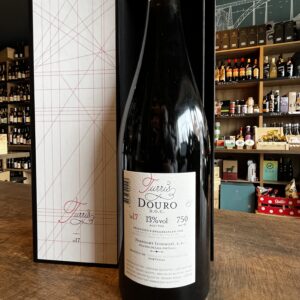
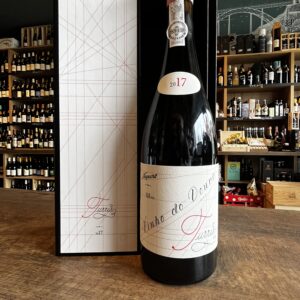 Turris is Niepoort's flagship red wine from the Cima Corgo region, more specifically from a very old South-facing vineyard whose vines are more than 130 years old , it is one of the oldest vineyards we know of in the region. This truly ancient, uncultivated vineyard lies hidden in the heart of the Douro Valley and is a true gift from our ancestors and refelcts every detail of nature and its area. These grapes from the Torre were always intended for one of Niepoort top wine Batuta and were a dream come true from Dirk Niepoort. The Turris was bottled quite early to preserve its freshness, minerality, youthful nature and the purity of its aromas and we expect it to show great aging potential. In addition to being a unique wine, each bottle is also unique because the labels were individually designed by the artist João Noutel.
Turris is Niepoort's flagship red wine from the Cima Corgo region, more specifically from a very old South-facing vineyard whose vines are more than 130 years old , it is one of the oldest vineyards we know of in the region. This truly ancient, uncultivated vineyard lies hidden in the heart of the Douro Valley and is a true gift from our ancestors and refelcts every detail of nature and its area. These grapes from the Torre were always intended for one of Niepoort top wine Batuta and were a dream come true from Dirk Niepoort. The Turris was bottled quite early to preserve its freshness, minerality, youthful nature and the purity of its aromas and we expect it to show great aging potential. In addition to being a unique wine, each bottle is also unique because the labels were individually designed by the artist João Noutel. -
 We felt this was the most appropriate name for this case as you will be the juror of these 12 bottles of wine. With that in mind we made a 'case' on this one that we think you will enjoy and scrutinize each every single one of them with a delightful outcome. In this case you will find 5 whites, 1 bubbly rosé and 6 delish reds. We rest our case! Whites Convés Branco Alentejo - The Serra do Mendro, located to the north of Vidigueira, creates a natural barrier that favors the retention of fresh winds from the Atlantic Ocean, causing greater rainfall and large thermal amplitudes. Cold mornings and nights and hot days promote a balanced maturation of the grapes, preserving their freshness and natural acidity. The gentle slopes and elevations of the landscape, as well as the clay-schist soils bring minerality, freshness and diversity to the wines of Herdade da Lisboa. It goes very well with fish and seafood dishes, salads or Asian dishes. Merinas Verdejo Organic - Lovely Organic from Castilla de La Mancha is an easy going, fruit forward wine. Generous flavours of citrus, peach, pear, lychee with a hint of jasmine, orange blossom and fennel. Fruity, bright and lively. Goes down very well on its own and pairs nicely with fish, chicken, vegetarian dishes and curry. Willowglen Gewürztraminer Riesling - Two of our favourite white grapes Gewürztraminer (80%) and Riesling (20%) make a delightful pairing in this Australian wine. As a result, you get an off dry floral wine with aromas of Turkish delight and rose petals with a zesty acidity. A popular style offering delicious aromatics making it the perfect choice for Thai or Indian food. Las Sastreria Garnacha Blanca - This delicious wine, belonging to the Haute Couture Print Collection, has been made with white Grenache grapes. It combines modernity and fruit character with the elegance of the Mediterranean style of this variety. Ideal with appetizers, seafood entrees, fish, white meat and pasta. Les Anges Sauvignon Blanc - Another one that won’t disappoint. This is a Val de Loire dry white. In Sancerre Kingdom this is an entry level Sauvignon Blanc that doesn't over promised but over delivers. Elegant and refreshing with a good burst of fruit and a touch of minerality. Bright, fresh yellow color. Flowery on the palate, fresh and delicate, fruity with a smooth finish. Produced thinking on sustainability it's a local wine for local people that got it's foot out of the region due to it's simplicity and quality La Jara Frizzante Rosé - A totally irresistible semi-sparkling Italian rosé from one of our favourite Prosecco producers, La Jara, but in this case they use a little bit of the red grape, Raboso, to give the wine its lovely pale coral colour. Dry on the palate and bursting with fresh strawberry notes reined in by the pithy bite of pink grapefruit. At 10.5% this is the wine to drink in the park with socially distanced friends, or with lunch in the garden before you’re really meant to be getting stuck into the vino! Bodegas Matsu El Picaro - The name El Picaro translates to The Rogue, and Matsu is the Japanese word meaning to wait, referencing the balance of attitude and patience that goes into making this wine. Fruit is hand harvested from a selection of 90-year-old vineyards in Toro (Spain) that are cultivated using biodynamic techniques. It has an intense aroma in which one can find blackberry, blueberry compote, cocoa and toasted almond characters. It is succulent and supple, and displays excellent fruit intensity, wonderfully supported by silky texture and fine tannins. The wine is fleshy and generous and will be a crowd pleaser. Colossal reserva tinto - "Colossal" is defined by something gigantic in place and time. This red from Lisbon has an intense ruby color and presents itself with a great concentration in the nose. Extremely rich aroma with predominance of red ripe fruits and some floral notes, well integrated with notes of spices coming from the ageing in French and American oak barrels. In the mouth it shows great complexity with notes of plums and blackberries. The finish is rich and elegant. Herdade Da Pimenta Colheita 2019 - The Portuguese rising region Alentejo is just made for such quality wines. The strong temperature differences between day and night temperatures have a beneficial effect on the nutrient absorption, acidity and sugar content of the grapes. This Pimenta Colheita Alentejo from Herdade da Pimenta shows deep ruby red with violet nuances. A complex scent of blueberries, white flowers and fine vanilla/wood aromas accompany the elegant fruit of the Pimenta Colheita. Chocolate and coconut notes are perceived on the palate, accompanied by delicate herbal and spicy notes, complex and balanced. The oak shows up in the Pimenta Colheita in a discreet caramel note with pleasant, fine-grained and soft tannins. The finish is concentrated, spicy and long-lasting. Château Haut Gravelier - Château Gravelier is located on superb hillsides on the edge of Entre Deux Mers, Bordeaux. Classic French blend of 70% Merlot 30% Cabernet Sauvignon. With deep colour, classic structure and unusually ripe flavours, this is classic claret to serve with roast beef, duck or T-bone steak. Heartland Stickleback 2016 Shiraz - This intense Shiraz swims against the current and harnesses the best that Australia has to offer. It is a wine of style and substance, offering dark fruits and hints of herbs. Col Di Sasso Castello Banfi - One of the best known and appreciated Banfi labels in the world, Col di Sasso, which translates to "Stony Hill", is a blend of Cabernet Sauvignon and Sangiovese cultivated on the most rocky and impervious slopes of the Banfi estate in Montalcino. The perfect marriage between these two grapes gives birth to a youthful yet concentrated and extremely fruity red wine. Great place to stay in Tuscany if you get a chance.
We felt this was the most appropriate name for this case as you will be the juror of these 12 bottles of wine. With that in mind we made a 'case' on this one that we think you will enjoy and scrutinize each every single one of them with a delightful outcome. In this case you will find 5 whites, 1 bubbly rosé and 6 delish reds. We rest our case! Whites Convés Branco Alentejo - The Serra do Mendro, located to the north of Vidigueira, creates a natural barrier that favors the retention of fresh winds from the Atlantic Ocean, causing greater rainfall and large thermal amplitudes. Cold mornings and nights and hot days promote a balanced maturation of the grapes, preserving their freshness and natural acidity. The gentle slopes and elevations of the landscape, as well as the clay-schist soils bring minerality, freshness and diversity to the wines of Herdade da Lisboa. It goes very well with fish and seafood dishes, salads or Asian dishes. Merinas Verdejo Organic - Lovely Organic from Castilla de La Mancha is an easy going, fruit forward wine. Generous flavours of citrus, peach, pear, lychee with a hint of jasmine, orange blossom and fennel. Fruity, bright and lively. Goes down very well on its own and pairs nicely with fish, chicken, vegetarian dishes and curry. Willowglen Gewürztraminer Riesling - Two of our favourite white grapes Gewürztraminer (80%) and Riesling (20%) make a delightful pairing in this Australian wine. As a result, you get an off dry floral wine with aromas of Turkish delight and rose petals with a zesty acidity. A popular style offering delicious aromatics making it the perfect choice for Thai or Indian food. Las Sastreria Garnacha Blanca - This delicious wine, belonging to the Haute Couture Print Collection, has been made with white Grenache grapes. It combines modernity and fruit character with the elegance of the Mediterranean style of this variety. Ideal with appetizers, seafood entrees, fish, white meat and pasta. Les Anges Sauvignon Blanc - Another one that won’t disappoint. This is a Val de Loire dry white. In Sancerre Kingdom this is an entry level Sauvignon Blanc that doesn't over promised but over delivers. Elegant and refreshing with a good burst of fruit and a touch of minerality. Bright, fresh yellow color. Flowery on the palate, fresh and delicate, fruity with a smooth finish. Produced thinking on sustainability it's a local wine for local people that got it's foot out of the region due to it's simplicity and quality La Jara Frizzante Rosé - A totally irresistible semi-sparkling Italian rosé from one of our favourite Prosecco producers, La Jara, but in this case they use a little bit of the red grape, Raboso, to give the wine its lovely pale coral colour. Dry on the palate and bursting with fresh strawberry notes reined in by the pithy bite of pink grapefruit. At 10.5% this is the wine to drink in the park with socially distanced friends, or with lunch in the garden before you’re really meant to be getting stuck into the vino! Bodegas Matsu El Picaro - The name El Picaro translates to The Rogue, and Matsu is the Japanese word meaning to wait, referencing the balance of attitude and patience that goes into making this wine. Fruit is hand harvested from a selection of 90-year-old vineyards in Toro (Spain) that are cultivated using biodynamic techniques. It has an intense aroma in which one can find blackberry, blueberry compote, cocoa and toasted almond characters. It is succulent and supple, and displays excellent fruit intensity, wonderfully supported by silky texture and fine tannins. The wine is fleshy and generous and will be a crowd pleaser. Colossal reserva tinto - "Colossal" is defined by something gigantic in place and time. This red from Lisbon has an intense ruby color and presents itself with a great concentration in the nose. Extremely rich aroma with predominance of red ripe fruits and some floral notes, well integrated with notes of spices coming from the ageing in French and American oak barrels. In the mouth it shows great complexity with notes of plums and blackberries. The finish is rich and elegant. Herdade Da Pimenta Colheita 2019 - The Portuguese rising region Alentejo is just made for such quality wines. The strong temperature differences between day and night temperatures have a beneficial effect on the nutrient absorption, acidity and sugar content of the grapes. This Pimenta Colheita Alentejo from Herdade da Pimenta shows deep ruby red with violet nuances. A complex scent of blueberries, white flowers and fine vanilla/wood aromas accompany the elegant fruit of the Pimenta Colheita. Chocolate and coconut notes are perceived on the palate, accompanied by delicate herbal and spicy notes, complex and balanced. The oak shows up in the Pimenta Colheita in a discreet caramel note with pleasant, fine-grained and soft tannins. The finish is concentrated, spicy and long-lasting. Château Haut Gravelier - Château Gravelier is located on superb hillsides on the edge of Entre Deux Mers, Bordeaux. Classic French blend of 70% Merlot 30% Cabernet Sauvignon. With deep colour, classic structure and unusually ripe flavours, this is classic claret to serve with roast beef, duck or T-bone steak. Heartland Stickleback 2016 Shiraz - This intense Shiraz swims against the current and harnesses the best that Australia has to offer. It is a wine of style and substance, offering dark fruits and hints of herbs. Col Di Sasso Castello Banfi - One of the best known and appreciated Banfi labels in the world, Col di Sasso, which translates to "Stony Hill", is a blend of Cabernet Sauvignon and Sangiovese cultivated on the most rocky and impervious slopes of the Banfi estate in Montalcino. The perfect marriage between these two grapes gives birth to a youthful yet concentrated and extremely fruity red wine. Great place to stay in Tuscany if you get a chance. -
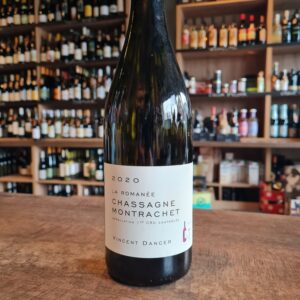 Vincent Dancer grew up in Alsace, where he inherited a love of wine and photography from his father. After studying engineering, his father suggested that Vincent spend some time in Burgundy, where his family owned some vines that were being rented out to cousins. Dancer was immediately hooked, and decided to settle in Chassagne-Montrachet and make wine from the five hectares of well-situated vineyards. The winery is small even by the standards of Burgundy, and despite Dancer’s reclusive nature, the wines are well known to a small circle of restaurateurs and wine-lovers who reliably take their miniscule allocation year after year. Dancer was the first producer in Chassagne to become certified organic, and there remains less than a handful of others. He is quietly individualistic, creating his own lean, bright, and savory style of wines, trusting his instincts and experience to make the best possible wine in his own way. Each cuvée, however, is truly a reflection of the terroir—from the rich, unctuous Meursault Perrières to the incisively fresh Chassagne Tête du Clos. It is not an exaggeration to say that the wines from Vincent Dancer are majestically unique, exceptionally delicious, and well worth the effort of seeking out.
Vincent Dancer grew up in Alsace, where he inherited a love of wine and photography from his father. After studying engineering, his father suggested that Vincent spend some time in Burgundy, where his family owned some vines that were being rented out to cousins. Dancer was immediately hooked, and decided to settle in Chassagne-Montrachet and make wine from the five hectares of well-situated vineyards. The winery is small even by the standards of Burgundy, and despite Dancer’s reclusive nature, the wines are well known to a small circle of restaurateurs and wine-lovers who reliably take their miniscule allocation year after year. Dancer was the first producer in Chassagne to become certified organic, and there remains less than a handful of others. He is quietly individualistic, creating his own lean, bright, and savory style of wines, trusting his instincts and experience to make the best possible wine in his own way. Each cuvée, however, is truly a reflection of the terroir—from the rich, unctuous Meursault Perrières to the incisively fresh Chassagne Tête du Clos. It is not an exaggeration to say that the wines from Vincent Dancer are majestically unique, exceptionally delicious, and well worth the effort of seeking out. -
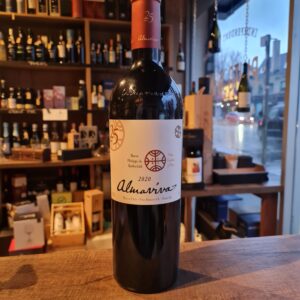 To celebrate the estate's 25th anniversary, the 2020 vintage by Almaviva is adorned with a special "25 años" label. Viña Almaviva was founded in 1997 following the collaboration between Baroness Philippine de Rothschild and Don Alfonso Larrain, President of Viña Concha y Toro. The Viña Almaviva project gives rise to fine Chilean wines that benefit from a rich French winemaking know-how and the unique expression of this Central Valley terroir. The name Almaviva, though it has an Hispanic sonority, belongs to classical French literature: Count Almaviva is the hero of The Marriage of Figaro, the famous play by Beaumarchais (1732-1799), later turned into an opera by the genius of Mozart. The label, meanwhile, pays homage to Chile’s ancestral history, with three reproductions of a stylized design, which symbolizes the vision of the earth and the cosmos in the Mapuche civilization. The design appears on the kultrun, a ritual drum used by the Mapuche. The label bears the name Almaviva in Beaumarchais’ own handwriting. Two great traditions thus join hands to offer the whole world a promise of pleasure and excellence. Located in the heart of the beautiful Maipo Valley, the Almaviva vineyard covers 50 hectares. The emblematic Bordeaux grape varieties thrive in this exceptional terroir. Almaviva has now become an essential reference for fine Chilean wines throughout the world. A particularly dry year, 2020 began with a cool, dry winter, resulting in a late budburst, particularly during the first two weeks of October. The spring and summer were marked by high temperatures but also by drought. These conditions favoured a rapid maturation of the vineyard and an early harvest, which ended three to four weeks earlier than in recent years. Despite this extreme climate and thanks to the rigour of the teams, the 2020 vintage reveals a fruity structure, a fresh expression and a rare tension.
To celebrate the estate's 25th anniversary, the 2020 vintage by Almaviva is adorned with a special "25 años" label. Viña Almaviva was founded in 1997 following the collaboration between Baroness Philippine de Rothschild and Don Alfonso Larrain, President of Viña Concha y Toro. The Viña Almaviva project gives rise to fine Chilean wines that benefit from a rich French winemaking know-how and the unique expression of this Central Valley terroir. The name Almaviva, though it has an Hispanic sonority, belongs to classical French literature: Count Almaviva is the hero of The Marriage of Figaro, the famous play by Beaumarchais (1732-1799), later turned into an opera by the genius of Mozart. The label, meanwhile, pays homage to Chile’s ancestral history, with three reproductions of a stylized design, which symbolizes the vision of the earth and the cosmos in the Mapuche civilization. The design appears on the kultrun, a ritual drum used by the Mapuche. The label bears the name Almaviva in Beaumarchais’ own handwriting. Two great traditions thus join hands to offer the whole world a promise of pleasure and excellence. Located in the heart of the beautiful Maipo Valley, the Almaviva vineyard covers 50 hectares. The emblematic Bordeaux grape varieties thrive in this exceptional terroir. Almaviva has now become an essential reference for fine Chilean wines throughout the world. A particularly dry year, 2020 began with a cool, dry winter, resulting in a late budburst, particularly during the first two weeks of October. The spring and summer were marked by high temperatures but also by drought. These conditions favoured a rapid maturation of the vineyard and an early harvest, which ended three to four weeks earlier than in recent years. Despite this extreme climate and thanks to the rigour of the teams, the 2020 vintage reveals a fruity structure, a fresh expression and a rare tension. -
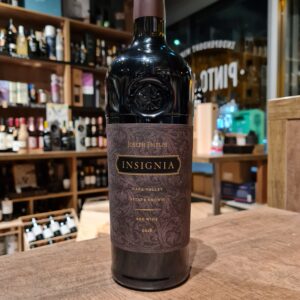 This wine is a gem in the middle of great wines produced in the renowned region of Napa Valley. Grapes are meticulously picked from the best parts of the different vineyards belonging to the estate. Great investment wine, with a fantastic long drinking window. The 2018 growing season in Napa Valley was marked by cool, mild weather. The cooler than normal spring delayed bud break, bloom and veraison by two weeks compared to the previous five years. The mild weather patterns in August and September allowed for excellent overall phenological ripening and development of a complex aroma and flavor profile in the finished wines. Outstanding flavor development and color were key indicators of this exceptional vintage. The winery was founded in 1973 by Joseph Phelps, a successful construction executive and entrepreneur whose early interest in wine led him to establish vineyards on a 670-acre former cattle ranch in Napa Valley. Over the next 42 years Joe became one of the most respected figures in the California wine industry, building Joseph Phelps Vineyards into a critically-acclaimed winery internationally known for its iconic wines and unwavering commitment to quality. Every wine in the Joseph Phelps portfolio is 100% estate-grown, overseen from grape to bottle by our dedicated winegrowing team. The family owns and farms 390 acres of vines in Napa Valley on eight estate vineyards in St. Helena, Rutherford, Oakville, the Stags Leap District, the Oak Knoll District, South Napa and Carneros, as well as 100 acres over two vineyards on the western Sonoma Coast. Strategically chosen over many decades, each vineyard has its own personality and brings a different characteristic to their wines. Their commitment to the estate-grown model is their way of ensuring consistency and the highest quality that can be achieved. Having estate vineyards give the winemaking teams unparalleled depth and diversity when it comes to producing Joseph Phelps wines. Only 12,400 cases were produced.
This wine is a gem in the middle of great wines produced in the renowned region of Napa Valley. Grapes are meticulously picked from the best parts of the different vineyards belonging to the estate. Great investment wine, with a fantastic long drinking window. The 2018 growing season in Napa Valley was marked by cool, mild weather. The cooler than normal spring delayed bud break, bloom and veraison by two weeks compared to the previous five years. The mild weather patterns in August and September allowed for excellent overall phenological ripening and development of a complex aroma and flavor profile in the finished wines. Outstanding flavor development and color were key indicators of this exceptional vintage. The winery was founded in 1973 by Joseph Phelps, a successful construction executive and entrepreneur whose early interest in wine led him to establish vineyards on a 670-acre former cattle ranch in Napa Valley. Over the next 42 years Joe became one of the most respected figures in the California wine industry, building Joseph Phelps Vineyards into a critically-acclaimed winery internationally known for its iconic wines and unwavering commitment to quality. Every wine in the Joseph Phelps portfolio is 100% estate-grown, overseen from grape to bottle by our dedicated winegrowing team. The family owns and farms 390 acres of vines in Napa Valley on eight estate vineyards in St. Helena, Rutherford, Oakville, the Stags Leap District, the Oak Knoll District, South Napa and Carneros, as well as 100 acres over two vineyards on the western Sonoma Coast. Strategically chosen over many decades, each vineyard has its own personality and brings a different characteristic to their wines. Their commitment to the estate-grown model is their way of ensuring consistency and the highest quality that can be achieved. Having estate vineyards give the winemaking teams unparalleled depth and diversity when it comes to producing Joseph Phelps wines. Only 12,400 cases were produced. -
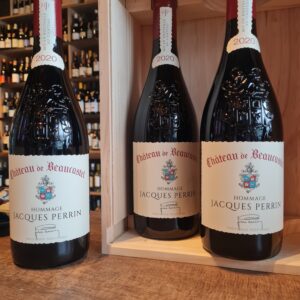 The Perrin family of Châteauneuf-du-Pape are one of the Rhône Valley’s greatest vineyard owners. With over 200 hectares of top level, prime vineyards at their fingertips, they have the terroir and skill required to produce some of the region’s finest wines. The estate traces its history back to a plot of Coudoulet vines bought by Pierre de Beaucastel in 1549. The estate was transferred into the Perrin family in 1909 through marriage, where it remains firmly to this day. Despite being one of the old guards of the region, they are also one of the most progressive estates. They were one of the first converts to organic and biodynamic faming in Châteauneuf-du-Pape, which they adopted in 1950 and 1974 respectively. A legendary Châteauneuf-du-Pape wine, Hommage à Jacques Perrin by Château de Beaucastel is one of the world's greatest wines. It brilliantly embodies the motto of the Perrin family: "A Grand Vin embodies emotion and civilisation, a legend that transcends time." The first vintage of this prestigious wine was produced in 1989. Produced in very limited quantities, the Hommage à Jacques Perrin wine comes from a unique terroir composed of rolled pebbles upon clay-limestone and silt soils in an exceptional vineyard located in the northern part of the Châteauneuf-du-Pape appellation, in the Rhône Valley. Vintage 2020 was relatively mild, the winter was punctuated by an episode of frost which had little impact on the vineyards, even the earliest plots. While the mildness of spring favoured vegetative development, a constant wind kept the soil cool. The hot, sunny summer was marked by both coolness and temperature variations between day and night, ideal conditions for ensuring a high-quality and even ripening of the grapes. Harvested at perfect maturity, the juicy and balanced grapes gave rise to a fine vintage.
The Perrin family of Châteauneuf-du-Pape are one of the Rhône Valley’s greatest vineyard owners. With over 200 hectares of top level, prime vineyards at their fingertips, they have the terroir and skill required to produce some of the region’s finest wines. The estate traces its history back to a plot of Coudoulet vines bought by Pierre de Beaucastel in 1549. The estate was transferred into the Perrin family in 1909 through marriage, where it remains firmly to this day. Despite being one of the old guards of the region, they are also one of the most progressive estates. They were one of the first converts to organic and biodynamic faming in Châteauneuf-du-Pape, which they adopted in 1950 and 1974 respectively. A legendary Châteauneuf-du-Pape wine, Hommage à Jacques Perrin by Château de Beaucastel is one of the world's greatest wines. It brilliantly embodies the motto of the Perrin family: "A Grand Vin embodies emotion and civilisation, a legend that transcends time." The first vintage of this prestigious wine was produced in 1989. Produced in very limited quantities, the Hommage à Jacques Perrin wine comes from a unique terroir composed of rolled pebbles upon clay-limestone and silt soils in an exceptional vineyard located in the northern part of the Châteauneuf-du-Pape appellation, in the Rhône Valley. Vintage 2020 was relatively mild, the winter was punctuated by an episode of frost which had little impact on the vineyards, even the earliest plots. While the mildness of spring favoured vegetative development, a constant wind kept the soil cool. The hot, sunny summer was marked by both coolness and temperature variations between day and night, ideal conditions for ensuring a high-quality and even ripening of the grapes. Harvested at perfect maturity, the juicy and balanced grapes gave rise to a fine vintage. -
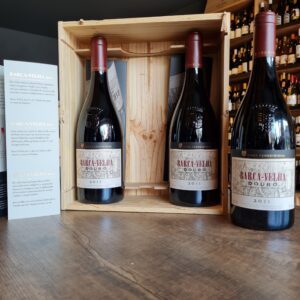 Casa Ferreirinha, was acquired by Sogrape Vinhos in 1987, its wines are synonymous with time and art. This has happened since its foundation, in the 18th century, by the hand of Bernardo Ferreira, who saw the formula refined by his descendants, especially by his granddaughter Dona Antónia Adelaide Ferreira, who affectionately became known as "Ferreirinha" or "Ferreirinha-da-Régua" for the people of that land. Through the hands of Dona Antónia, who twice widowed herself at the head of a large company, Ferreira consolidated itself admirably. Her entrepreneurial spirit taught her to foresee, decide, create, teach and love, making her a figure of great projection and charisma. Barca Velha is the result of the passion of Fernando Nicolau de Almeida (Casa Ferreirinha Head Winemaker in 1952), who envisioned a high quality Douro Red Wines made with the aging potential of Vintage Ports. The first harvest was 1952. Barca Velha is only released in exceptional years, current head winemaker Luis Sottomayor began his career at this house as an apprentice learning directly from Fernando Nicolau D'Almeida. ''2011 was an extraordinary year-one of the best ever in Douro-Intense and exceptional quality. When this wine was born, we soon realized that it would be destined for Barca-Velha”. But even so, it was necessary to pass the great test of time with distinction. In the barrels, first, and then in the bottle, it was followed and evaluated over nine years, until the final decision was made.
Casa Ferreirinha, was acquired by Sogrape Vinhos in 1987, its wines are synonymous with time and art. This has happened since its foundation, in the 18th century, by the hand of Bernardo Ferreira, who saw the formula refined by his descendants, especially by his granddaughter Dona Antónia Adelaide Ferreira, who affectionately became known as "Ferreirinha" or "Ferreirinha-da-Régua" for the people of that land. Through the hands of Dona Antónia, who twice widowed herself at the head of a large company, Ferreira consolidated itself admirably. Her entrepreneurial spirit taught her to foresee, decide, create, teach and love, making her a figure of great projection and charisma. Barca Velha is the result of the passion of Fernando Nicolau de Almeida (Casa Ferreirinha Head Winemaker in 1952), who envisioned a high quality Douro Red Wines made with the aging potential of Vintage Ports. The first harvest was 1952. Barca Velha is only released in exceptional years, current head winemaker Luis Sottomayor began his career at this house as an apprentice learning directly from Fernando Nicolau D'Almeida. ''2011 was an extraordinary year-one of the best ever in Douro-Intense and exceptional quality. When this wine was born, we soon realized that it would be destined for Barca-Velha”. But even so, it was necessary to pass the great test of time with distinction. In the barrels, first, and then in the bottle, it was followed and evaluated over nine years, until the final decision was made. -
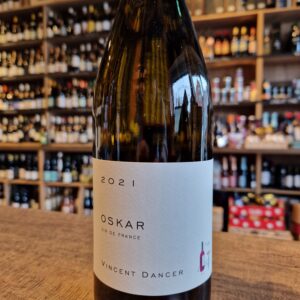
This is a unique wine from a once off production from Vincent Dancer. Oskar is the result of Vincent Dancer frustration with the low yeald of his top four Vineyards due frost that happen right after the fruit started to grow resulting in huge losses. Oskar is the name of Théo Dancer’s Australian Shepard.
So, this incredibly rare, one-off bottling comprises of a roughly equal amount of Chassagne-Montrachet 1er Cru La Romanée, Chassagne-Montrachet 1er Cru Tête du Clos, Meursault 1er Cru Perrières and Grand Cru Chevalier-Montrachet. Naturally, by blending across villages, Dancer has had to declassify this wine and chose Vin de France instead of the risker option of Bourgogne Blanc! Of course, this will have little bearing on a wine that is set to become a unicorn.
This true rarity from the Dancer estate is a pure sensory pleasure of great rarity, as only two barrels were produced. Pinto Wines has the enormous honour to stock Vincent Dancer in general nevermind this unique wine.
If you'd ask me I wouldn't drink this wine with food or any other beverage. Simply on it's own and and my best friend and wife. But if you really have to pair it then I would suggest stinky cheeses, seafood and why not the coq au vin
-
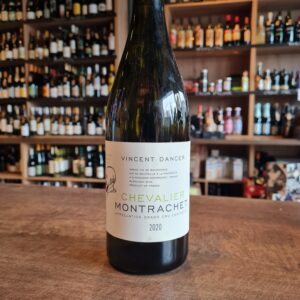
Few winemakers affirm their stellar reputation as convincingly as Vincent Dancer with his ethereal Chevalier Montrachet Grand Cru Blanc 2020. Immaculately crafted in the revered vineyards of France's Burgundy region, it is an unparalleled masterpiece from one of the region's mavericks.
Going against the grain of traditional Burgundian winemaking, Vincent Dancer opts for no battonage and low usage of new oak in producing this Grand Cru Blanc. He relies on sustainable viticulture practices, underscoring nature's ability to produce a near mystical balance of flavours without intervention. This purity of approach culminates in an elegant, nuanced white experienced in this bottle.


